True Merit: Ensuring Our Brightest Students Have Access to Our Best Colleges and Universities
Acknowledgements
We gratefully acknowledge the contributions of our colleagues, without whom this report would not have been possible.
At the Cooke Foundation, Lauren Matherne analyzed data on Cooke Scholars and wrote the scholar profiles contained in this report; Harold Levy, Giuseppe Basili, Dana O’Neill, and Elizabeth Davidson provided thoughtful critique and review; and Marc Linmore and Nick Ciorogan thought creatively of ways to communicate the report’s findings to a larger audience through video.
We thank our research collaborators: Dr. Ozan Jaquette and doctoral student Andrew Blatter at the University of Arizona for their analyses of Department of Education data, Paul Mott of the Common Application for partnering with us, Dr. Daniel Hae-Dong Lee and Evan Hodges-LeClaire from Censeo Consulting Group for their analyses of data from the Common Application, Experian Data Quality for providing income estimates for Common Application students, Heather Durosko and colleagues at the National Association for College Admission Counseling for sharing historical trend data on selective colleges admissions factors, and Abigail Seldin for sharing data on Pell Abacus.
Finally, our gratitude to Brian Myers at Myers Advertising for creatively designing the final graphic layout of the report.
True Merit
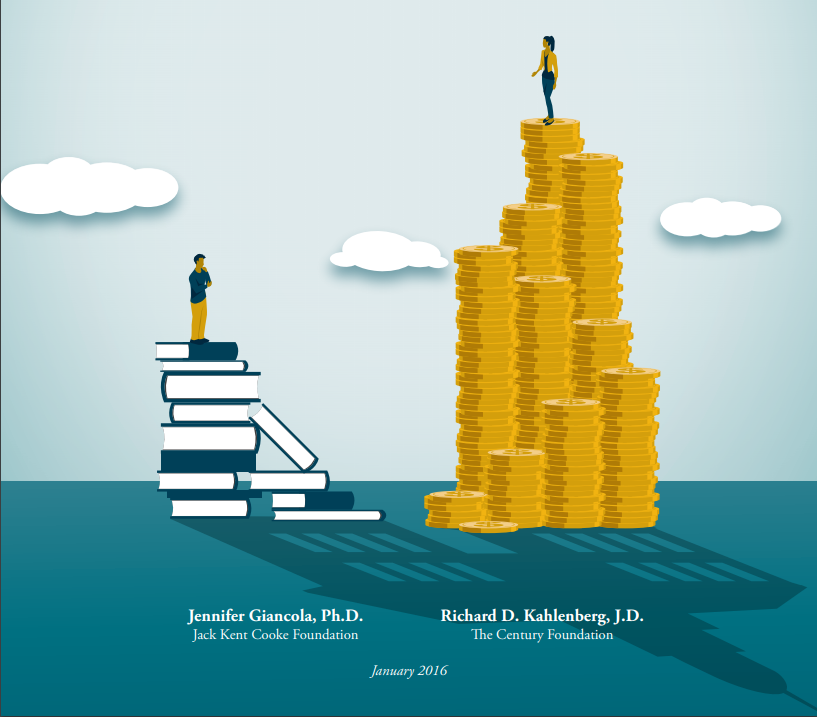
The admissions process used today in America’s most selective colleges and universities is a classic case of interest group politics gone awry. Athletic coaches lobby for athletes. Trustees advocate for students who are the children of potential donors. Faculty members lobby for the children of other faculty and for high scoring students, who tend to be wealthy. And nobody champions or fights for smart, low-income students.
The result is an admissions process reduced to a series of preferences. Taken together with other widely-used admissions practices, such as allowing applicants who take the SAT multiple times to submit only their highest scores, these preferences are part of a system that is profoundly unfair to top students from low-income families. Access to our nation’s best colleges and universities is increasingly a function of wealth and station, not academic merit.
It comes as no surprise therefore that American postsecondary education is highly stratified by socioeconomic class, with 72 percent of students in the nation’s most competitive institutions coming from families in the wealthiest quartile.1 High-achieving, students from the bottom socioeconomic quartile are only one-third as likely to enroll in selective colleges and universities compared to those from the top socioeconomic quartile.2 In short, we are relegating our brightest minds from low-income families to attend institutions with fewer resources, lower graduation rates, lower paying employment prospects, and reduced access to the upper echelons of leadership and commerce. This unequal treatment cheats the striver out of obtaining the best education available and denies society at large the benefits of having the most educated workforce possible. It’s a story of demography determining destiny.
This past December 2015, the United States Supreme Court began re-evaluating the role of race-conscious affirmative action in college admissions with the re-argument of the case of Fisher v. University of Texas. For the second time, the Court is reviewing the constitutionality of the University’s admissions program. The fact that the Supreme Court has chosen to hear the case again does not bode well for race-conscious considerations in college admissions.3 There is no better time to examine how selective colleges and universities choose their students, particularly as our research suggests many admissions criteria unfairly prevent many of our most talented low-income students from gaining admittance.
Although individual aspects of college admissions have been analyzed before, in this report we for the first time comprehensively analyze the entire admissions process as it impacts the high-achieving, low-income applicant to a selective college or university. Our conclusion: the deck is stacked against them, notwithstanding the advent of “need-blind” admissions and the claims made by selective colleges and universities that they are trying to accommodate the low-income student. We find that there is significant evidence that most low-income students lack the information to navigate admissions practices effectively and that many top low-income students, because of “sticker shock,” are deterred from even applying to highly selective schools. We conclude that the preferences and some other admissions practices at highly selective colleges and universities, taken together, have resulted in a surprising, and probably inadvertent, result:
Being admitted to a selective institution is actually harder for the high-achieving, low-income students than for others.
We were also surprised by both the extent of the individual disadvantages and the uniformity of approach across all highly selective colleges and universities reviewed. On the other hand, we were encouraged to find that the vast majority of high-achieving, low-income students who do manage to enroll in selective colleges and universities succeed at a high level.
To address the problems uncovered, we believe that selective colleges and universities should institute a preference for otherwise qualified students who come from low-income families. Such an approach would recognize that to overcome the burdens of poverty and nonetheless perform at a high level is itself an indicator of ability and perseverance; true merit, properly understood, recognizes both scholastic achievement and the importance of the distance traveled from a low-income high school to an elite college or university.
National data and Cooke Scholars
confirm that the vast majority of
high-achieving, low-income students
who enroll in selective colleges and
universities succeed at a high level.
Unfortunately, too few of them enroll.
If the Supreme Court limits the extent to which institutions can rely on race-conscious affirmative action, reliance on a preference for low-income students will be an important admissions criterion to insure diversity in their entering classes. Not only—in the words of President Obama—is there still an “intersection” between race and income in this country, but our dramatically decreasing social mobility makes emphasis on economic indicators all the more imperative.
About this Report
This report is divided into four sections. First, we demonstrate that high-achieving, low-income students are underrepresented at selective institutions. Next, we explain why they do not apply in greater numbers and what role the students’ knowledge about the admissions process plays. In the third section, we review how the selection process itself—with its preferences and other practices—disadvantages high-achieving, low-income students. In the final section, we suggest strategies selective institutions should use to recognize the merit of high-achieving, low-income students, drawing on practices that some institutions have employed to maintain diversity on their campuses in response to state-bans on race-conscious affirmative action.
Terminology
This report focuses on admissions at selective colleges and universities; those that receive more applications than they accept and whose enrolled students have high levels of academic preparation. In our research, we utilize the Barron’s Profiles of American Colleges classification system, combining the “Most Competitive” and “Highly Competitive” classifications to identify the nation’s top selective schools. In 2015, there were 91 “Most Competitive” and 102 “Highly Competitive” institutions. For details on the classifications, please see Appendix A.
We define high-achieving as those students who scored in the top academic quartile on a 10th grade reading and mathematics assessment administered as part of the Education Longitudinal Study and who graduated from high school. We acknowledge that students attending the most selective institutions often come from the top 10 to 20 percent of their class. However many students at those colleges and universities come from below the top academic decile and perform well. Moreover, low-income students who score in the top 25 percent despite facing myriad hurdles, are likely to have as much or greater academic potential in the long run as students who look better on paper but have been given many advantages. To capture these extraordinary low-income students in our sample, we generally use a top 25 percent cutoff.
Within this group of high-achieving students, we compare the experiences of students from families with greater or lesser financial and social capital. Our analyses use a composite measure of socioeconomic status (SES) based on family income, parents’ highest level of educational attainment, and parents’ occupational status. SES is often used instead of income both because income is not adjusted for cost-of-living variations, which can be significant as one moves about the country, and because, in surveys, a student’s reported knowledge about her parents’ occupation and education level may be more precise than the knowledge of her parents’ income. Additional research referenced in this report sometimes uses income quartiles to divide students. For simplicity’s sake, throughout this report, we use the phrase low-income to refer to students in the bottom SES or income-quartile. For details on the data sources and methods, please see Appendix B.
Underrepresentation
High-Achieving, Low-Income Students Are Underrepresented at Selective Institutions
The selectivity of higher education institutions attended by students in this country directly correlates with their family’s SES (Figure 1). Students from families in the bottom economic quartile comprise only three percent of enrollment in the most competitive schools, while those from the top economic quartile comprise 72 percent.
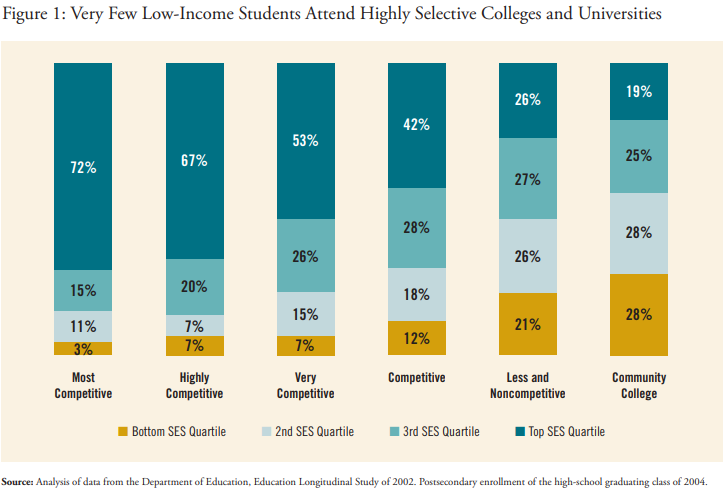
This situation has not improved in recent years,4 despite selective institutions’ well-advertised increased commitment to “need-blind admissions” and “no-loan financial aid” packages.5 Our analysis of the latest institutional data available from the U.S. Department of Education reveals that the underrepresentation of lower-income students at highly selective colleges has not changed significantly in the past ten years.
Federal Pell funding increased dramatically under the Obama Administration.6 As a result, more students received the Pell grant amount for which they were eligible, and Pell enrollment increased dramatically.7 Yet, while the percent of students receiving Pell grants has risen in other sectors of higher education, it has not increased appreciably in selective colleges, suggesting that the number of low-income students has in fact remained static (16 percent in 2000; 17 percent in 2013) (Figure 2).
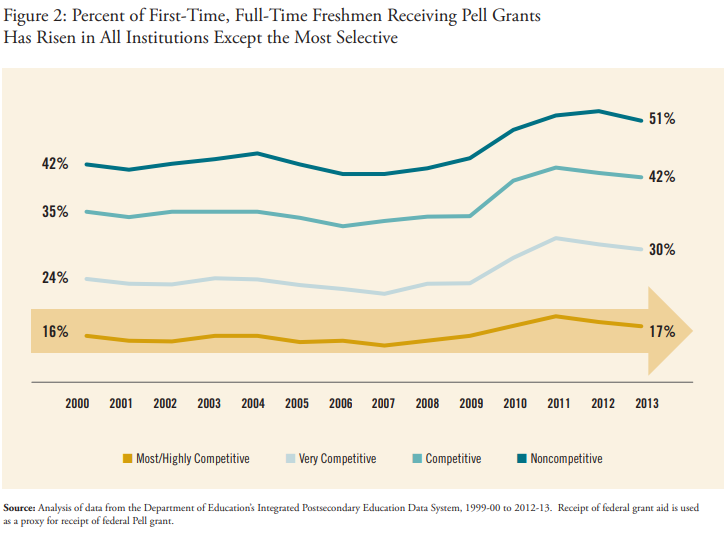
Skeptics might say these disparities reflect differing levels of academic preparedness or ability. Certainly it’s true that wealthy students—who grow up in affluent neighborhoods, attend well-resourced schools, participate in after-school enrichment, and attend summer programs at their parent’s expense—are more likely to emerge from high school well-prepared for the rigors of a selective college education. Analysis of average SAT scores by family income makes this clear.8
Yet hidden within these numbers are thousands of students from economically disadvantaged households who, despite attending less-resourced schools and growing up with less intellectual stimulation and advantages, do extremely well in school, love learning, are extraordinarily bright and capable, and would do very well at selective institutions if offered admissions. They are just being ignored.
The experience of the Jack Kent Cooke Foundation in finding such students is directly on point. Since 2002, the Cooke Foundation has funded the education of 891 undergraduate students who attended either a most or highly competitive institution. In recent years, these students’ combined math and critical reading SAT scores ranged from 1170 to 1600. Of those who entered as freshman from high school, 95 percent graduated, earning a cumulative grade point average (GPA) of 3.5. The graduation rate of those who entered as transfer students from community college was even higher—97 percent—with a final average cumulative GPA of 3.6. Collectively these students, who have enrolled at 146 selective institutions (Figure 3), represent the best and brightest students from families with financial need, and demonstrate how successful more high-achieving, low-income students could be with more systematic support.
Cooke Scholars
exemplify success:95% of Cooke College
Scholars graduate,
earning an average
GPA of 3.5.97% of Cooke Transfer
Scholars graduate,
earning an average
GPA of 3.6.
Cooke Scholars represent only a fraction of the potential talent pool. In 2015, the Cooke Foundation received more than 3,300 applications from lower-income high school seniors whose SAT/ ACT scores were in the top 15 percent; if past enrollment patterns are any guide, at most only one in three of these applicants will ultimately attend a highly selective college or university. Researchers have estimated there are between 25,000 and 35,000 students who score in the top decile on the SAT or ACT and come from families in the bottom income quartile.9 Comparing these figures to enrollment data from COFHE schools, researchers estimate that highly selective schools could increase the representation of low-income students by 30 percent without compromising SAT or ACT standards and with increased social diversity.10
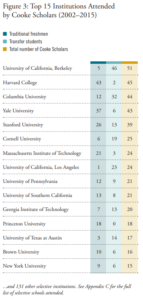
Our research confirms what study after study has demonstrated: the vast majority of high-achieving students from economically disadvantaged households do not enroll in selective colleges or universities (Figure 4).11 Indeed, the likelihood that a top student from a low-income family will find his or her way to a selective college is remote. Using the Education Longitudinal Study of 2002, we found that high-achieving students from the wealthiest families were three times as likely to enroll in a highly selective college as those from the poorest families (24 versus 8 percent). Other researchers have demonstrated that this trend holds true even among the most talented low-income students who score in the top ten percent nationwide on the SAT or ACT.12
The underrepresentation of
high-achieving, low-income students at
the nation’s selective institutions stems
from two factors: low-income students
are less likely to apply to selective schools,
and low-income students who do apply
receive inadequate consideration in the
admissions and financial aid process.
This underrepresentation of high-achieving, low-income students at the nation’s selective colleges stems from two factors: 1) low-income students are less likely to apply to selective schools, and 2) low-income students who do apply receive inadequate consideration in the admissions and financial aid process. The importance of attending a selective institution is described briefly in the following two pages, after which we discuss these two contributing factors in Parts 2 and 3 of this report.
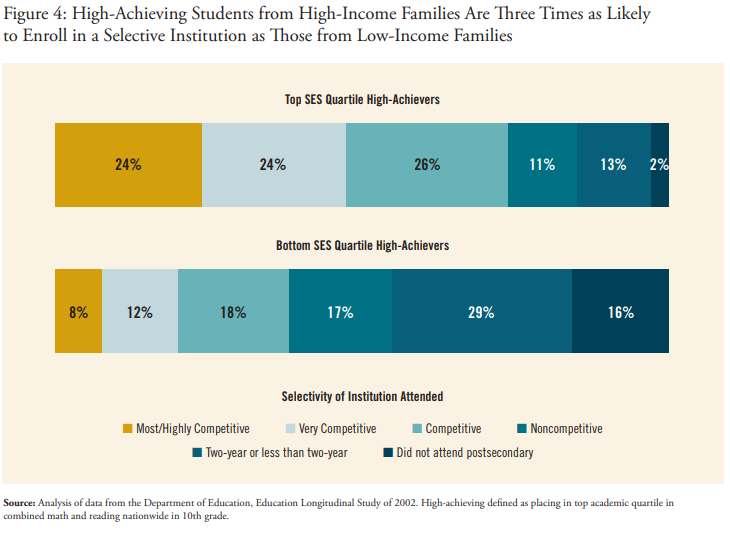
Institutional Selectivity Matters
Commentators sometimes contend that the selectivity of one’s college matters less than individual determination or ability.13 However, our analysis is unequivocal: high-achieving students who attend more selective schools graduate at higher rates, earn higher incomes, and are more likely to pursue a graduate degree (Figure 5). This remains true even after controlling for student’s academic ability.14 In other words, where you go to school matters.
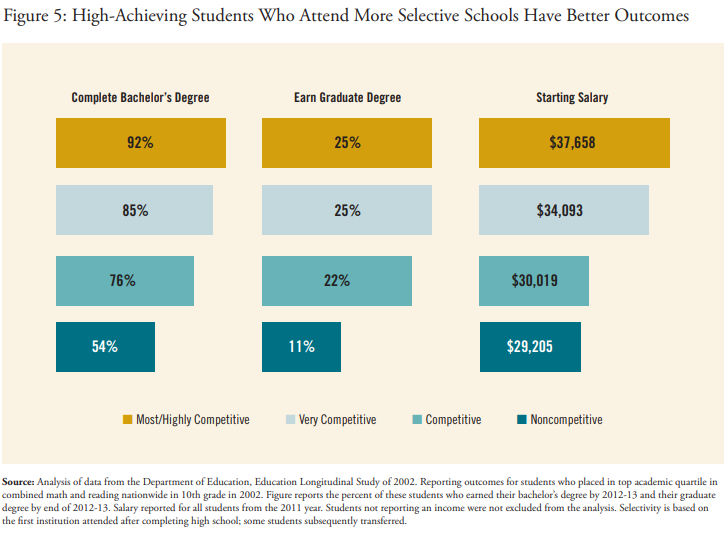
This relationship is especially true for low-income students, who benefit from the increased retention supports—in particular specialized counseling services—selective institutions often provide.
In fact, an earlier analysis by the Jack Kent Cooke Foundation shows that only at the most selective schools do high-achieving, lower-income students graduate at rates equal to students from higher income backgrounds (Figure 6).
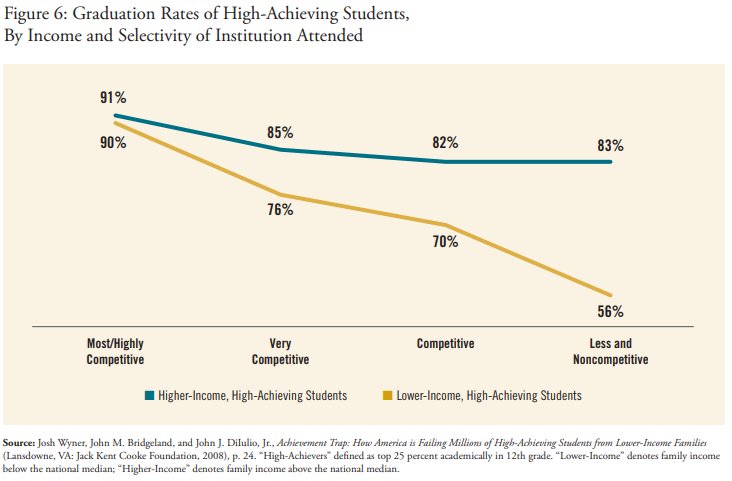
Our review of findings from other researchers aligns with our conclusions. It suggests that students also receive a higher quality education at selective colleges, at least as measured by per pupil spending (Figure 7). They are taught by some of the world’s most distinguished teachers, as evidenced, for example, by the high number of Nobel Laureate prize winners who have taught at selective colleges and universities.15
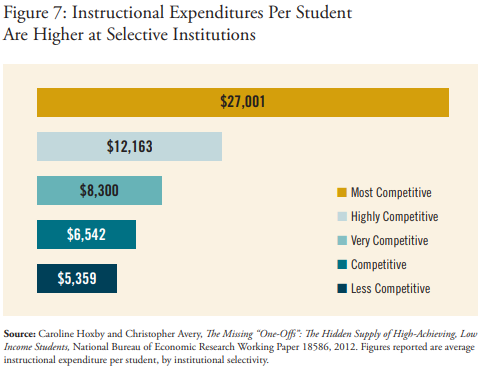
Top employers typically recruit from selective colleges and universities.16 And, selective institutions cultivate our nation’s leadership: 49 percent of corporate industry leaders and 50 percent of government leaders graduated from only 12 selective colleges and universities.17 If we want a nation where at least some of our leaders know first-hand what it is like to grow up poor, then the doors of selective institutions must be open to students from all communities. Low-income students depend on higher education as a route to social mobility, but college will never be the great equalizer if the brightest of the poor cannot even get in the door.
The vast majority of
high-achieving students
from low-income
households do not enroll
in selective colleges or
universities, but those
who do receive a
more resourced education
and are more likely
to graduate.
Under-Matching
The Persistent Problem of Under-Matching
Thousands of low-income students every year graduate from high school with high grades, high test scores, and strong academic motivation but do not apply to selective colleges and universities. Our research shows that only 23 percent of high-achieving, low-income students apply to a selective school, compared with 48 percent of high-achieving, high-income students (Figure 8). Termed “under-matching” by researchers, many high-achieving, low-income students choose not to apply to schools whose student bodies have high levels of academic ability on par with their own, and instead apply to schools where the average student’s academic capacity is lower than their own.18
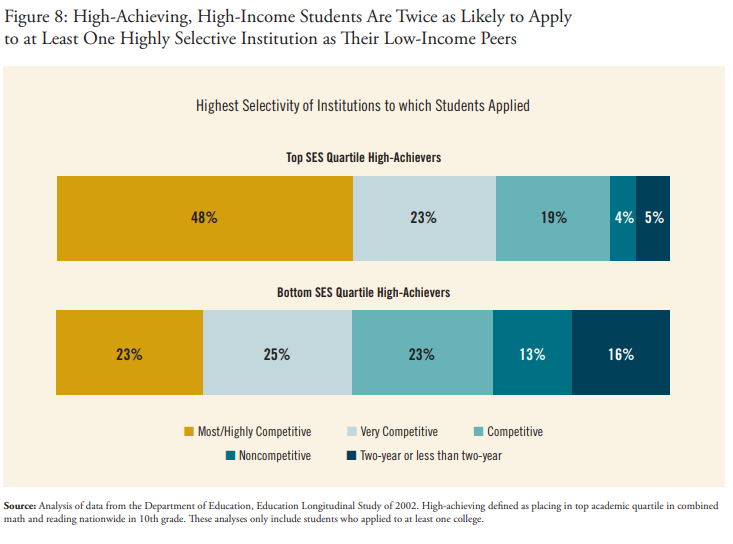
The Jack Kent Cooke Foundation has seen this pattern among applicants for its scholarships. Since 2002, the Cooke Foundation has supported high-achieving students from low- to moderate income backgrounds through college scholarships for high school seniors and community college transfer students. The eligibility criteria for a Cooke Scholarship are rigorous: students must have an un-weighted cumulative GPA of 3.5 or higher, and high school seniors must also have scored in the top 15 percent on the SAT or ACT. Yet even within this self-selected group of motivated, talented students, 38 percent do not list a Most or Highly Competitive institution among their top three college choices when they apply.19
Why Don’t More High-Achieving, Low-Income Students Apply to Selective Schools?
William R. Fitzsimmons, dean of admissions and financial aid at Harvard College for over two decades, has said, “Our goal in admissions is to attract the best students to the college.”20 However, for the most part, only the best students from higher income families end up applying to selective institutions such as Harvard, not the best from all income brackets. In particular, students from the bottom income quartile comprise only 11.7 percent of applicants and 9.1 percent of admitted students at the nation’s most selective institutions.21 Put another way, “for every high-achieving, low-income student who applies [to selective institutions] there are from 8 to 15 high-achieving, high-income students who apply.”22 Researchers examining under-matching have identified two primary reasons why high-achieving, low-income students do not apply to selective schools.
1. They don’t think they can afford it.
While the cost of higher education has been rising for decades, the stated tuition and fees at elite colleges (especially private institutions) have skyrocketed, even after adjusting for inflation (Figure 9). Low-income families, seeing these “sticker prices,” often fail to understand that with financial aid, attending a selective school might actually cost them less than their local public university (Figure 10). Indeed, one study found that at one selective school, students with family income less than $24,000 paid less than $1,000 per year despite the institution’s stated price of $33,831.23
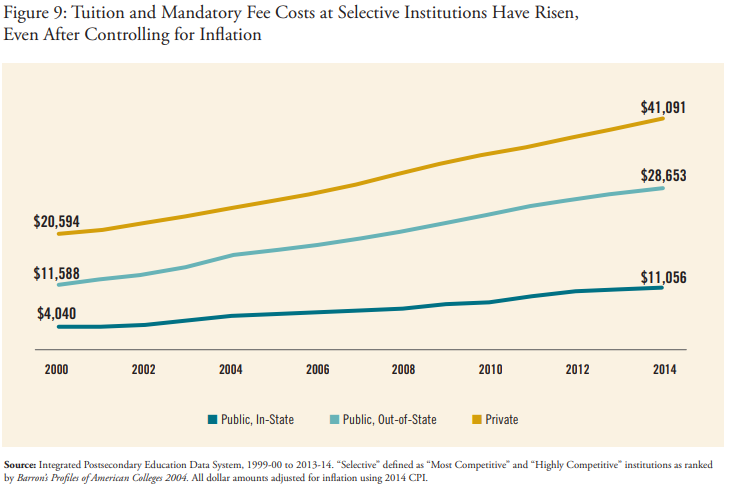
Our analysis of applications submitted through the Common Application organization (“Common App”) finds that 84 percent of high-achieving students with family incomes below $20,000 fail to obtain the Common App fee waiver for their college applications, despite clearly being eligible for one.24 This finding suggests that it is often a lack of knowledge about how college financial aid works that stands in the way of students applying, not students’ actual desires or financial circumstances.
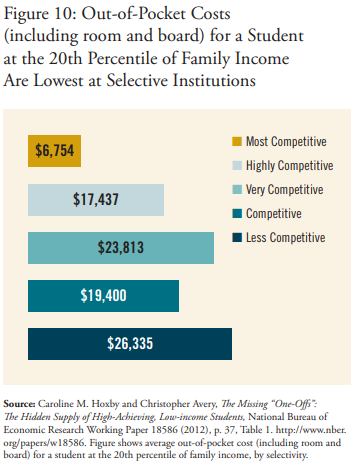
Stories abound of high-achieving, low-income students who are unaware of how much financial aid they might be eligible to receive from a selective institution. One author tells of Karen, a high-school valedictorian from a low-income family who received a perfect score on the verbal SAT, and who aspired to attend an Ivy League institution. Karen’s parents, who had not themselves attended college, questioned the value of attending an out-of-state private institution and told Karen they could not afford the tuition (not understanding the amount of financial aid they would receive). In the end, Karen matriculated at a small school that was close to home, finding out only later that spring that it would have been free to attend the Ivy institution of her dreams.25
Some scholars question whether this lack of information is exacerbated by intentional actions on the part of the institutions themselves. For example, researchers examining the webpages of selective institutions offering no-loan financial aid packages found it exceedingly difficult to locate clear information about the policies. Observing that financial aid policies are more clearly communicated to the higher education community (via avenues such as the Chronicle of Higher Education) than to students and families themselves, the researchers questioned whether the institutions deliberately obfuscate information about their financial aid offerings so as to limit the number of low-income students who apply while still receiving credit for their “social justice efforts.”26 If true, this challenges the purpose of “need blind” enrollment policies; it suggests these need-friendly policies are just a form of public relations.
If selective colleges and universities were to address these issues, there would be a dramatic shift in student behavior on the part of low-income, high-performers. Research is clear that changing high-achieving, low-income students’ understanding of how college financial aid works can dramatically increase the number of applications they submit to selective schools. By sending students an inexpensive mailing costing $6, researchers were able to increase the percent of high-achieving, low-income students who applied and were admitted to a match institution by 31 percent.27 Other studies have found that simply sending semi-customized text messages to students’ cell phones can increase their completion of the Free Application for Federal Student Aid (FAFSA), a necessary precursor to obtaining a federal Pell grant.28 This is a critical first step as our research suggests that only 71 percent of high-achieving, low-income students complete the FAFSA.29 The failure of more than a quarter of high-achieving, low-income students even to apply for federal financial aid—which provides a straight tuition subsidy for the lowest income students—suggests that there is far more confusion about the true cost of higher education than is generally understood.
2.They don’t receive accurate, individualized guidance.
Even when students understand how financial aid works, they may not believe they “belong” in a selective school. Many high-achieving, low-income students do not know anyone in their social network who has attended a top institution.30 One study found that only 36 percent of low-SES high school valedictorians felt it was important to attend a “prestigious college,” compared with 50 percent of high-SES valedictorians.31 Sometimes these misguided beliefs are unwittingly fueled by well-meaning high school counselors. A 2008 Cooke Scholar, Abigail M., has described what it was like applying to colleges and universities from her small, rural high school in Nebraska:
“There were only 57 students in my graduating class. Most of us went to college, with a few opting for trade schools, jobs, or the military. Those who chose to attend four-year colleges all went to the University of Nebraska or nearby state schools. My high school emphasized the importance of applying to college, so everyone in my senior class was required to fill out an application to the University of Nebraska. That being said, my classmates didn’t seem to be aware that attending, or applying to, a private university was an option. When I expressed interest in attending one, my counselor was eager to help, but having had only a couple of students over the years attend private colleges and universities, she lacked knowledge about the opportunities and requirements. She was unfamiliar with the Common Application. One other boy in my class was interested in applying to a school using the Common App system, so my counselor asked me if I would be willing to sit down and show him how, after I figured it out.”
Research is clear
that changing
high-achieving, lowincome
students’
understanding of how
college financial aid
works can dramatically
increase the number of
applications they submit
to selective schools.
There are numerous efforts underway to address counseling needs. The Cooke Foundation sponsored the College Advising Corps to train recent graduates to provide counseling. From 2005 to 2014 the College Advising Corps served over 500,000 students.32 In Chicago, the school district added college counseling in low-income schools and it resulted in significantly increased college enrollment.33 The Coalition for Access, Affordability, and Success—made up of more than 80 selective institutions—recently created a digital tool to make the application process more accessible to low-income students. The Common App organization has created a comprehensive training resource with ready-to-present slide decks, accompanying scripts, and complementary video tutorials.34 Similarly, the ECMC Foundation has sponsored Pell Abacus, a net price calculator for Pell-eligible students that provides approximations of actual college costs. Yet 40 selective colleges and universities currently block Pell Abacus.35 To be successful, these new systems will actually need to reach large numbers of low-income students who lack adequate guidance and technological support, and be welcomed by colleges and universities. Colleges and universities themselves have an important role to play here.
Admission Process
Selective Institutions’ Admissions Processes Disadvantage Low-Income Students
While student behaviors certainly contribute to enrollment inequalities, so do the admissions practices at selective colleges and universities themselves. As demand for higher education and the number of institutions to which students apply have both grown, competition for seats in the nation’s more selective institutions has skyrocketed, leaving admissions officers with the daunting task of choosing the most meritorious from an excess of highly qualified candidates (Figure 11).36 Unfortunately, the processes they use are unfair to high-achieving, low-income students at every turn.
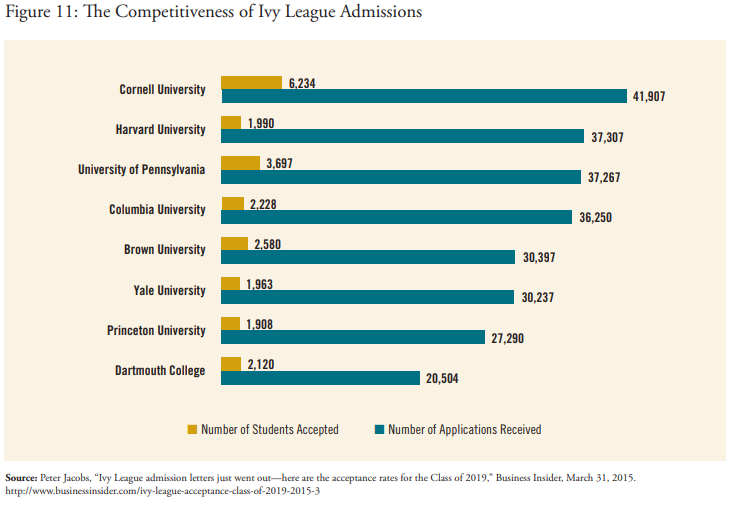
Academic Assessment
Selective institutions seek to admit students with demonstrated high levels of academic talent who will succeed in rigorous and demanding academic programs. On its website, for example, Princeton University calls for admitting “a varied mix of high-achieving, intellectually gifted students.”37 A recent study where admissions officers of highly selective institutions were polled found that they cited grades, strength of curriculum, and admission test scores as the three most important factors in their admissions processes (Figure 12). Although neutral on its face, the admissions process as it is implemented is actually skewed dramatically against the poor.
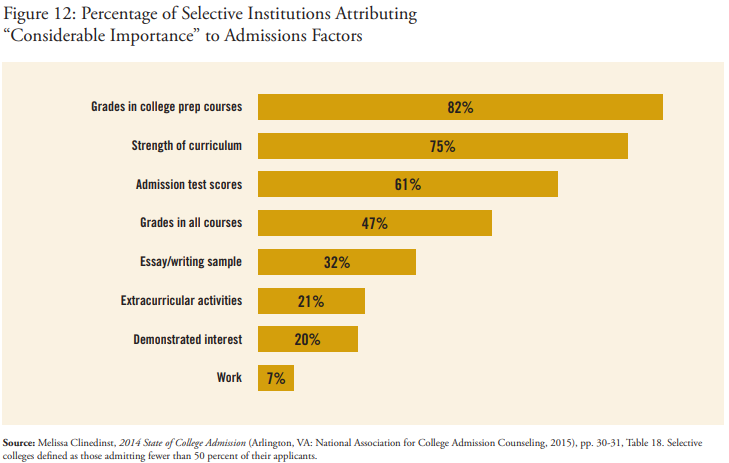
With tens of thousands of applications to review (in 2014, for example, Yale received over 30,000 applications for 1,360 spots38) admissions officers must rely to some extent on quantitative measures of students’ abilities. And with some estimating that 70 percent of the applications received by selective institutions are worthy of consideration, admissions officers rely on an initial “Academic Index” score to reduce the applicant pool.39 This primarily quantitative review relies on SAT and ACT scores, GPAs (weighted and un-weighted), and metrics of curriculum rigor (advanced courses taken, etc.) to rank applicants. According to a 2014 study, 76 percent of the nation’s most selective institutions apply an initial academic review to all applications to weed out applicants who are not capable “of doing the work.”40 Applicants not making the initial cut are excluded from further review, and their applications are never read. Several aspects of this process indirectly reduce the chances of admission of high-achieving, low-income students.
Most importantly, high-achieving, low-income students are less likely to have access to college level coursework than other students. This is one of the key factors in constructing most Academic Indexes. Low-income students are one third as likely to take Advanced Placement or International Baccalaureate (AP/IB) courses as other students. This is partially a function of attending rural and small schools, which are less likely to offer AP/IB programs, and partially a function of being steered away from higher level courses even when AP/IB programs are offered.41 The failure to take AP/IB courses means that a significant percentage of low-income students who could perform well in highly selective colleges will never even be considered because they have a low Academic Index score.
Related to this, students taking advanced courses in high school often receive a weighted grade—i.e., the addition of a predetermined numerical value to their course grade when calculating their GPA. This over-weighting is intended to account for the greater difficulty of the material, however, use of weighted GPAs in admission reviews puts low-income students at a disadvantage; with fewer AP/IB courses available to them, their GPA is capped at the standard maximum (typically 4.0), whereas students with greater access to advanced coursework have the potential of reporting higher cumulative GPAs. In some schools, it is routine for students taking AP/IB courses to report a “weighted GPA” of up to 5.0.42
The overreliance on standardized tests is also concerning, especially given that institutional reliance on SAT and ACT test scores has risen.43 In 2007, 48 percent of admissions officers at selective colleges reported placing “considerable importance” on SAT/ACT scores, while by 2014 that figure had risen to 59 percent.44 No doubt this change is driven in part by the need to limit the number of applications that are read, and by the weight placed on average test scores by competitive college ranking regimes. In the U.S. News & World Report’s “Best Rankings,” SAT/ACT scores comprise 65 percent of the “student selectivity” score used in the magazine’s rankings (up from 50 percent in 2010).45 Small differences in average test scores can increase an institution’s ranking, leading to greater prestige, larger numbers of applicants, and a higher “yield rate” (the percent of admitted students who enroll).46
This rising emphasis in college admissions on SAT and ACT scores is problematic, because the initial quantitative screening likely removes a disproportionate number of low-income students from further consideration. The research does not justify such weight being placed on incremental test scores as it is entirely unclear whether small differences in standardized test scores are indicative of a difference in students’ ability to complete rigorous academic work and (most importantly) to graduate from selective institutions. One study found that within selective institutions, while students with a combined (math and critical reading) SAT score below 1000 had lower graduation rates, there was only a small difference in graduation rates between students with scores between 1000 and 1200, on the one hand, and those with scores above 1200, on the other (86 versus 96 percent, respectively).47 Another study found that SAT scores cannot, with any accuracy, predict which students will earn a high GPA (over 3.75).48
While high test scores are indicative of advanced academic ability, somewhat lower scores do not always indicate lack of advanced ability. This is classically a “false negative,” a score that suggests lack of ability in a student who is actually quite capable. Particularly with respect to high-achieving, low-income students, a marginally lower test score may well be the result of a lack of coaching or the lack of resources that would enable the student to take the SAT or ACT tests multiple times. Our analysis of the Education Longitudinal Study data confirms that high-achieving students from the wealthiest families are twice as likely to have taken SAT preparatory courses or tutoring as those from the poorest families (Figure 13). It is in response to these discrepancies that the College Board recently partnered with Khan Academy to offer free, online SAT preparation, which is no doubt helpful, but cannot completely replace in-person instruction.
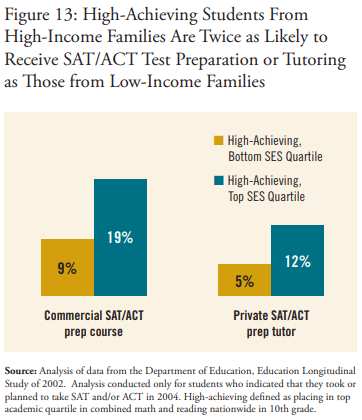
While the conventional wisdom is that test coaching only has a marginal effect—perhaps 30 points out of 1600 on the SAT reading and math tests—for years Princeton Review claimed an average gain of 255 points for students who took its SAT “ultimate classroom course.”49 Numerous studies support the proposition that coaching programs aid achievement test performance. At least one study has suggested that test coaching is particularly effective for high SES students.50 If a difference in test results excludes a low-income student from further consideration—even if the difference itself is small—then the seemingly marginal advantage becomes very significant, perhaps dispositive of a student’s chances for admission.
The father of the SAT, Harvard’s President James Bryant Conant, in the 1930s said he preferred relying on the aptitude test in preference to an achievement test because he feared that the latter could be the subject of coaching. “[T]hey favored rich boys whose parents could buy them top-flight high school instruction.”51 It is telling that 85 years later we are still worrying about the fairness of the test with respect to the low-income (or at least not wealthy) student.
The growing movement for colleges and universities to become “test-optional,” removing the SAT/ACT test score requirement, is seen by many as an effort to reduce emphasis on standardized tests that might disadvantage low-income or minority students. Unfortunately, research shows that test-optional policies have had little effect on low-income and minority student enrollment, though they have resulted in increased institutional prestige via higher college rankings, the result of having SAT/ACT scores reported only by students with higher scores.52
Demonstrated Interest
Seemingly innocent practices that have an unforeseen but clearly detrimental impact on the chances of high-achieving, low-income students abound. Some admissions offices give preference to students who demonstrate strong interest in the college by visiting the campus in person, for example. In fact, at one in five selective institutions “demonstrated interest” receives “considerable importance” in the admissions decision.53 Driving this preference is the institutional desire to offer admission to students who are more likely to accept, thus increasing the institution’s “yield rate,” the percentage of applicants granted admission who actually enroll. Such emphasis, unfortunately, penalizes low-income students, whose family financial constraints and parents’ work schedules often preclude them from making campus visits. We are unaware of any institutions that, recognizing this unfairness, attempt to offset this penalty by only attributing value to demonstrated interest for students who have the means to visit.
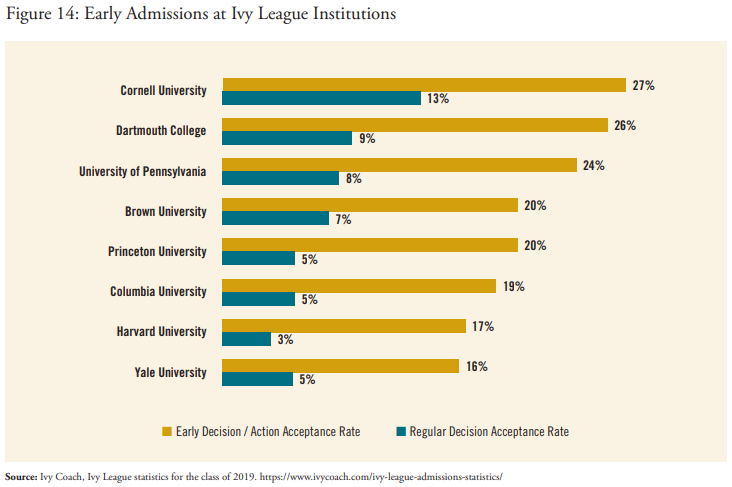
Institutions also reward students who submit their application early. Under one variant, “early action,” students may still apply to other schools, while under another, “early decision,” students must commit to attend if awarded admission. Institutions uniformly admit early admissions applicants at higher rates than other applicants. In the Ivy League, for example, early admissions applicants are admitted at rates three to five times higher than other applicants (Figure 14).
One study estimates that students applying early admission receive the equivalent of a 100 point bonus on the SAT.54 Yet low-income students are often unaware of the advantages of applying early and, in any event, are not generally in a position to apply using the binding early decision process. Offers of early decision come before students receive their acceptance and financial aid packages from other institutions to which they applied, but if accepted, students who apply early decision must attend that school. This practice puts low-income students at a disadvantage because they are unable to commit to an institution before they have received their financial aid packages from all the schools to which they are accepted.
Our analysis of Common App data confirms the hypothesis that low-income students are disadvantaged by the early decision process: 29 percent of high-achieving students from families making more than $250,000 a year applied early decision, compared with only 16 percent of high-achieving students from families with incomes less than $50,000.55 In short, low-income students are half as likely to apply early, even though doing so would dramatically increase their likelihood of admission; this remains true even when applying to institutions that practice so-called “need-blind” admissions, i.e., the practice of separating the admissions function entirely from financial aid. (Of course, making admissions decisions without respect to considering a student’s family income can have the perverse effect of working against the low-income student who has overcome seemingly insuperable barriers and yet emerged with a strong academic record. Much depends on the actual administration of the policy.)
Recognizing the unfairness of the early admissions practice for low-income students, in 2006 Harvard College, Princeton University, and the University of Virginia eliminated early admissions from their processes entirely. When no other selective institutions followed suit, all three institutions reinstated the practice within five years.56 As a consequence, the unfairness continues.
Being “Hooked”: Non-Academic Preferences That Disadvantage Low-Income Students
The admissions process contains far more insidious advantages for the high-income applicant. Even when high-achieving, low-income students apply with extraordinarily strong grades, high test scores, a well-constructed application, and have managed to visit campus despite the cost, their application might still fall short of others due to the well-documented practice through which certain applicants receive a boost in the review process for non-academic factors. These factors—which have nothing to do with a student’s academic strengths—include the applicant’s athletic ability, being an underrepresented minority, having a parent or relative who previously attended the institution, or having sufficient means to afford to pay full tuition. Admissions officers describe such students as being “hooked,” and the preference for these extraneous factors rarely benefits high-achieving, low-income students.
Athletic Preference
While many selective institutions state that they do not offer athletic scholarships (only need-based aid), admissions officers readily admit to offering preferential review and reserved spaces for recruited athletes.57 The New York Times reports that at Amherst College, for example, 75 of the 450 incoming freshman spaces are reserved for recruited athletes identified by coaches, quoting the admissions dean as saying, “athletic recruiting is the biggest form of affirmative action in American higher education, even at schools such as ours.”58 Many of these slots go not to minority or low-income students, however, but to wealthy, suburban, White students who play sports such as squash, sailing, crew, and water polo.59 Students with strong athletic ability are often admitted despite having weaker academic credentials than other students, with one analysis of 90,000 students at selective colleges and universities estimating that recruited athletes are as much as four times as likely to be admitted as other similarly qualified applicants. The athletic preference is particularly objectionable because, once admitted, these athletes under-perform academically, earning lower college grades than their high school grades and SAT/ACT scores would have predicted.60 Moreover, the popular notion that recruited athletes tend to come from minority and indigent families turns out to be just false; at least among the highly selective institutions, the vast bulk of recruited athletes are in sports that are rarely available to low-income, particularly urban, applicants.
Affirmative Action: Racial Preference
Race-conscious affirmative action has been used for decades to address past inequities and offer students from disadvantaged minority groups (particularly African Americans and Latinos) a better chance at gaining access to college. As a result, in selective colleges and universities today, underrepresented minorities receive a 28 percentage point boost in admissions compared to White students with the same credentials.61 Low-income students who are not minorities receive no such advantage. This preferential treatment is intended to benefit minority students who may have suffered from historical prejudice, inequity, or outright discrimination.
The preference is also intended to benefit institutions because racial and ethnic diversity has been shown to contribute to enriched learning environments by exposing students to students and faculty who come from diverse backgrounds.62 Selective institutions are particularly attuned to the value of diversity, many having only recently cast off histories of racial, religious, and ethnic exclusion. Harvard College, for example, today states on its admissions webpage, “We believe that a diversity of backgrounds…among students who live and learn together affects the quality of education in the same manner as a great faculty or material resources.” Even the Supreme Court has noted that “the nation’s future depends upon leaders trained through wide exposure to the ideas and mores of students as diverse as this Nation of many peoples,” although the policy of affirmative action in college admissions, as already noted, is actively under review.63
In the context of higher education admissions, “diversity” often translates to mean racial and ethnic diversity. And yet, while racial discrimination remains an important problem in American society, today economic status has actually eclipsed race as the primary source of academic disadvantage. The Black/White test score gap was once twice as large as the gap between low-income and high-income students, but today precisely the reverse is true: the income gap is twice as large as the race gap, and growing (Figure 15).64
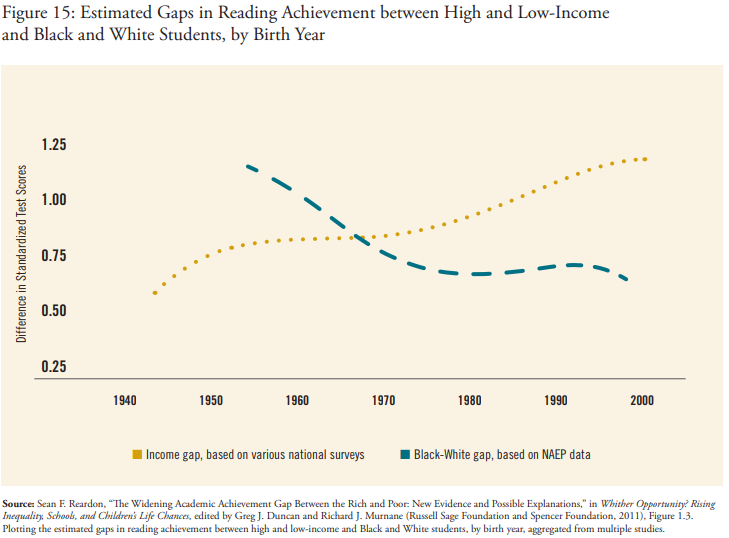
As more minority families successfully break through segregated glass ceilings and establish themselves in the middle and upper classes, it is increasingly their children who gain admittance to selective institutions, not the children of minorities living in impoverished, underprivileged neighborhoods. Indeed, 86 percent of Black students at selective colleges are middle or upper-class.65 This was far from the original intention of race-conscious affirmative action in college admissions.
Financial Aid to Students Who Can Pay Their Own Way: the Mediocre Student Preference
Some institutions indirectly discriminate against students who cannot pay the cost of college (tuition, fees, room and board) by providing non-need-based merit scholarships to higher-paying, lowerability students. Only about 100 institutions (out of approximately 4,200 nationally) are “need-blind,” meaning that they do not take into consideration at all a student’s ability to pay.66 In other words, the vast majority of colleges and universities do consider income when reviewing applications, and this sometimes results in the shifting of scarce financial aid resources away from those most in need to non-need “merit aid” programs.67
At the same time, the absolute dollars available to students with financial need has been reduced. S. Georgia Nugent, former president of Kenyon College, notes that “financial aid available to the lowest-income students has plummeted, and financial aid to the highest has soared.”68 Data from the U.S. Department of Education confirms this trend. Nationwide, the percent of undergraduates receiving non-need-based institutional aid (for athletics or “academic merit” scholarships) has actually risen for wealthy students in the top income quartile, but not for those in the bottom income quartile (Figure 16). It is an embarrassment of the first order, defensible only insofar as the tuition payments are necessary to balance academic budgets. Even then, in essence, colleges are making the mercantile decision to live off the backs of less talented students while sacrificing the more talented poor.
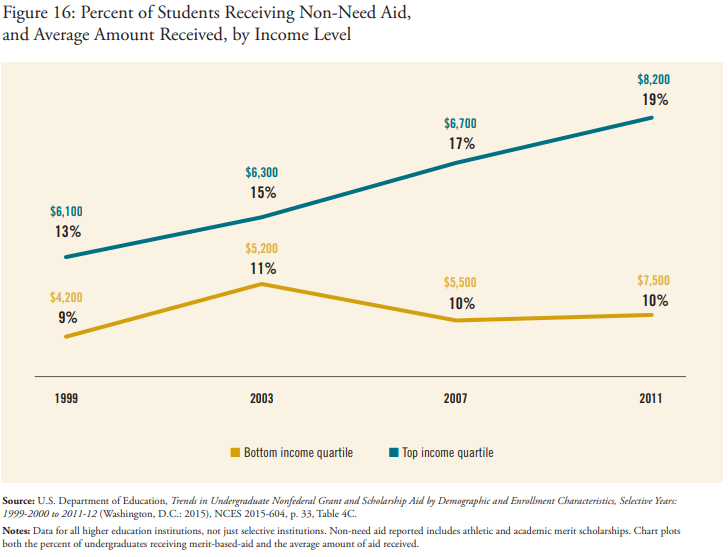
Legacy Preference
Perhaps the preference that is the most antithetical to the principle of true merit selection is the “legacy preference.” Under legacy admissions, institutions give admissions preference to children of alumni.69 In some elite institutions, legacy applicants are automatically advanced to the second round of admissions.70 The practice is doubly unfair, because legacies are disproportionately wealthy, otherwise privileged, and White, so the preference constitutes in essence affirmative action for the rich.71
Yet the use of the legacy preference is widespread at elite colleges and universities. Over 80 percent of our most selective institutions employ legacy preferences.72 Although schools often claim that preferences for the offspring of alumni are just a “tiebreaker” among roughly equal candidates, research suggests legacies receive the equivalent of a 160 point boost on the SAT (out of 1600 points).73 Harvard’s legacy admit rate is 30 percent—four times the admit rate of regular applicants.74
The best argument in favor of the legacy preferences is that it encourages greater charitable giving to the college or university by its alumni. However, researchers have found no evidence that this is true.75 It has also been suggested that abandoning the legacy preference would ultimately make little difference in actual admissions, because most legacy applicants—having benefited from the generous academic supports that wealthier students receive— would likely be admitted anyway for their own merit. If that’s true, then the existence of the preference should not matter.
Why, in a country where we fought a war of independence to get away from inherited aristocracy, do so many of our leading universities employ preferences based on lineage? The very existence of the preference allows donors to buy their children’s way into selective schools. It is as though competitive academic placement applies only to the poor, while admissions among the wealthy is open to the highest bidder.
The Deck is Stacked Against High-Achieving, Low-Income Students
By the time all of the admissions preferences and processes (such as early decision and demonstrated interest) are added up, there is little room left for high-achieving, low-income students, nor do these students receive any preferential treatment of their own for having overcome the often steep barriers that result from growing up in poverty. In fact, analysis of 13 selective institutions’ admissions data suggests that while being an athlete, underrepresented minority, or legacy provides considerable advantage in college and university admissions, emerging from low-income families and being a top student provides no boost whatsoever (Figure 17).
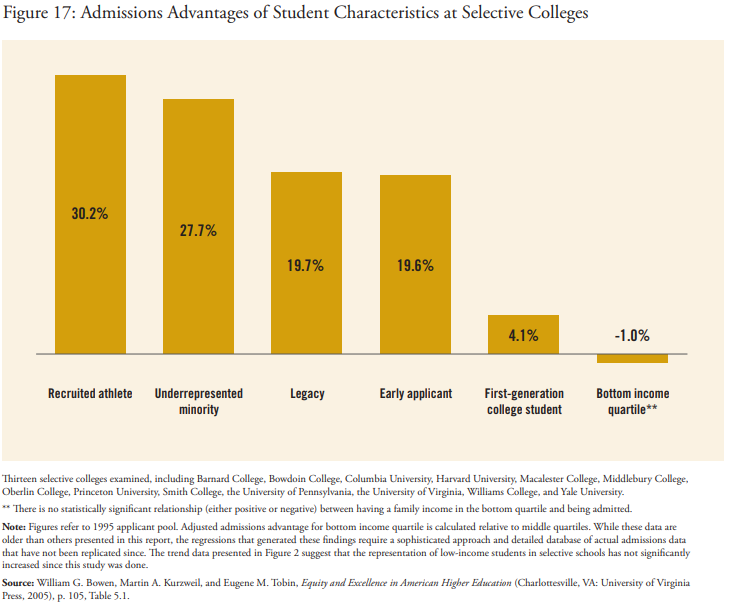
We conclude that the preferences and some admissions processes in selective colleges and universities, taken together, have resulted in a surprising, and probably inadvertent, result:
Being admitted to a selective institution is actually harder for the high-achieving, low-income student than for others.
Many selective colleges and universities would dispute this conclusion. They would claim that they already provide a boost for economically disadvantaged students because their admissions process recognizes that merit should consider not just a student’s endpoint but the distance traveled from low-income high school to elite college or university.76 But what institutions say is very different than what they do, and when the data are examined, multiple researchers have found that being in the bottom income quartile (relative to the middle quartiles) has no positive effect on admissions.77
In fact, being low-income may actually constitute a disadvantage in admissions. While the nature of the data does not yet provide a firm statistical basis to draw such a conclusion, anecdotal evidence is rife. When all these admissions preferences are summed up, the number of unhooked application slots is profoundly limited; estimated by one university chancellor as comprising only 40 percent of the available seats at Ivy League institutions.78 In the words of another college official, to be accepted at an elite institution an unhooked candidate “has to walk on water.”79
The Solution
Increasing Access for High-Achieving, Low-Income Students
A 1200 SAT score and 3.5 GPA means something very different for a student who grew up in a low-income single-parent household and attended substandard schools than a wealthy prep school graduate who was “shot out of a cannon,” in the words of Amherst admissions officer Tom Parker.80 Current admissions practices fail to acknowledge this difference. In fact, as discussed, they actually punish the striver.
Our current system of admissions is difficult to justify. Public colleges and universities receive taxpayer support because they are supposed to benefit the public at large. Likewise, private, non-profit colleges and universities receive favorable tax treatment because they are supposed to serve the broader public interest. (At the upper-end of the spectrum, for example, Princeton University is estimated to receive the equivalent of $105,000 per pupil in public support annually through preferential tax treatment and other subsidies.)81
Given their charge of advancing the public interest, colleges and universities should strive for admissions systems that honor true academic merit and seek to identify those students who have the best scholastic records, are otherwise most deserving, and most likely to contribute to society. Admission based on true merit rather than an incidental status for which they have no responsibility or which has nothing to do with their academic abilities would consider traditional indicators of excellence (such as grades, test scores, and leadership skills) and, in projecting future contributions to society, would also consider the obstacles that students have overcome.
We do not disparage the argument that admissions officers must “build a class” such that it contains a diverse group, including athletes, legacies, minorities, student government leaders, artists, musicians, poets, as well as pure scholars. However, we believe the pendulum has swung too far. At base, colleges and universities are academic institutions, not social clubs.
Poverty Preference: A Necessary Corrective
To address the problem that students with severe financial need are being overlooked by the existing admissions process, selective colleges should institute a preference for students who are low-income. There are three reasons that this remedy should be adopted. First, it recognizes that students who are otherwise competitive and have overcome poverty’s burdens have demonstrated a persistence and tenacity that is worthy of recognition and is likely to distinguish them in later life. Second, it offsets the myriad of preferences and processes outlined in this report that have the cumulative effect of unfairly handicapping such students. Third, it provides a viable alternative strategy to promote racial diversity on campus, particularly if the Supreme Court precludes or limits race-conscious affirmative action in the currently pending Fisher II Case.
A handful of institutions have already instituted policies that de facto or de jure constitute a poverty or low-income preference. In the ten states where racial affirmative action programs have been banned at public universities (by voter referendum, executive order, or legislature action), a number of innovative strategies have been adopted to open up opportunities for economically disadvantaged students including:
- removing preferences for the wealthy,
- broadening merit definitions and assessment processes to better identify high-achieving students from varied socioeconomic backgrounds,
- expanding outreach strategies, and
- increasing financial aid. Figure 18 outlines how states used these strategies and their results. Each strategy is then discussed in more detail on pages 31–33.
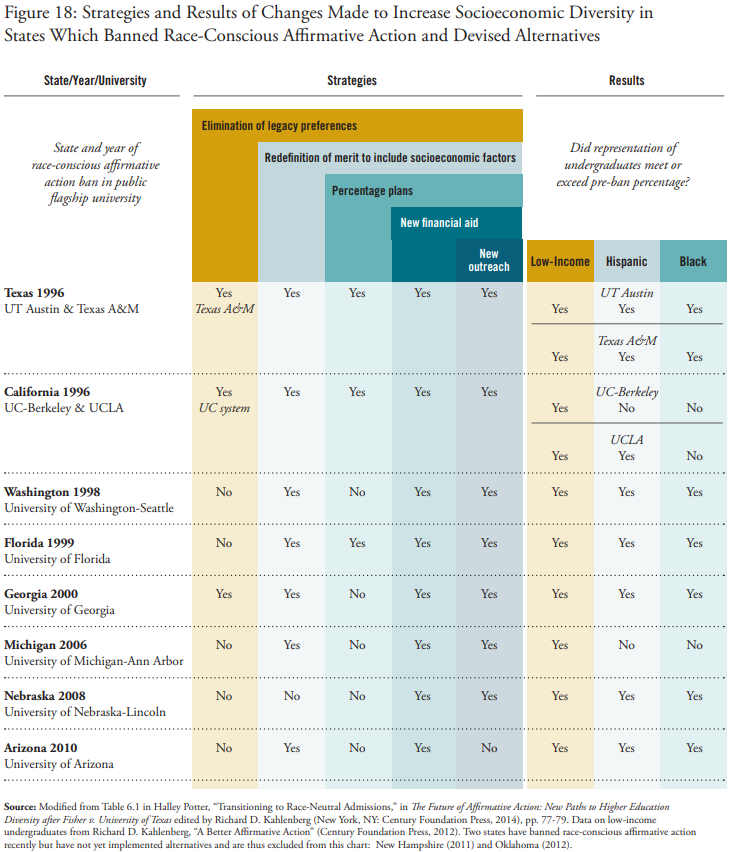
Removing Preferences for the Wealthy
Public flagship universities in Texas, California, and Georgia have dropped legacy preferences entirely. At the University of Georgia, for example, administrators decided to eliminate the use of the legacy preference, because it disproportionately benefits White and wealthy students. The move was fiercely opposed by alumni, but according to admissions vice president Nancy McDuff, the university “has not encountered noticeable fundraising challenges as a result of the change.” Along with other steps—such as adding considerations of socioeconomic status (SES) to admissions decisions—the elimination of legacy preferences helped the University of Georgia to match earlier levels of Black and Latino representation previously achieved through overt racial preferences.82
To overcome the burdens of poverty
and nonetheless perform at a high
level is itself an indicator of ability
and perseverance; true merit, properly
understood, recognizes both scholastic
achievement and the importance of the
distance traveled from a low income high
school to an elite college or university.
Redefining Merit to Include “Distance Traveled”
Public institutions have created three approaches to broadening their review of academic merit: (1) giving weight to SES factors in the admissions review, (2) holistic review in which applicants’ accomplishments are reviewed in context of their home and school environments, and (3) “percentage plans” under which the top students from each high school are offered admission to the state’s flagship universities. Some institutions apply these new processes across their entire applicant pool; others have designated a set percentage of enrollment slots to be filled using this alternative method.
To date, eight states have instituted new admissions preferences for low-income and working-class students of all races. These institutions assign points for factors that might put students at an academic disadvantage, including: concentrated neighborhood poverty, single parent home, lack of wealth or financial assets, first generation college goer, language spoken at home, poverty level of the applicant’s high school, and average SAT or ACT of the applicant’s high school.
In California, for example, the University of California-Los Angeles (UCLA) Law School adopted a class-based affirmative action program that takes into consideration both the SES of an applicant’s family (parental education, income, and net worth), and an applicant’s neighborhood (percentage of families headed by singleparent households, proportion of families on public assistance, and percentage who had not graduated from high school). The program roughly tripled the proportion of law students who were the first in their family to attend college, and African American applicants were 11.3 times as likely to be admitted through the SES program as other programs. UCLA bar passage rates reached an all-time high after the SES program replaced an earlier race-conscious program.83
Other institutions have adopted a policy of holistic review, in which—in contrast to need-blind review—reviewers are provided with in-depth contextual information about each applicant’s home and school, and charged with assessing the student’s accomplishments in light of what supports they were given and what obstacles they have overcome. At the University of California, Berkeley, for example, the admissions department provides readers with school-specific data, which is updated annually with information from the state Department of Education and Berkeley’s applicant pool, so that readers know critical personal information about each student, such as parental occupation, high school poverty level, or the range of SAT/ACT test scores in the student’s high school.84 Adding in SES factors to the admissions review provides readers with a context to evaluate both a student’s abilities and the obstacles that he or she has overcome. Indeed, new research released this past November suggests that simply providing admissions officers with this additional data increases the rate of admission of low-income students.85
The third strategy is so-called percentage plans, where state flagship universities offer admissions to the top students in each school or district. In Texas, California, and Florida, officials have created policies to admit students who graduated at the top of their high school classes. The Texan Top Ten Percent Plan, enacted by the state legislation, initially provided automatic admissions to students in the top ten percent of every high school class, irrespective of SAT or ACT scores; the figure was subsequently reduced to seven percent because of space constraints (percentage plan admits are capped at three-quarters of the freshman class).86 In part because of high levels of racial segregation in Texas high schools, the percentage plan has produced as much (indeed slightly greater) African American and Latino representation in 2004 as it had using race in the mid-1990s. The percentage plan also produced higher levels of SES diversity. The program has been supported both by liberal urban minority legislators and conservative rural lawmakers, as constituencies from both groups benefit. Research indicates that minority students admitted through the percentage plan have performed as well or better than White students admitted with slightly higher average test scores.87
Reducing Under-Matching Through Outreach and Financial Aid
Some institutions, rather than changing their admissions criteria, have sought to increase the representation of low-income students among the applicant pool. Recognizing that under-matching contributes to the under-representation of low-income students, six states have invested in creating new partnerships with schools located in low-income or minority neighborhoods. These partnerships fund regional admissions centers, recruitment weekends targeting underrepresented regions and high schools, efforts to increase community college transfer applications, and K-12 partnerships that offer college preparatory classes and high school courses offering college credit.
In two states, programs have been created specifically to facilitate transfer from community colleges to four-year universities to promote economic and racial diversity.88 In California, for example, after the 1996 voter ban on affirmative action, efforts were made to increase the proportion of students at UC campuses who transferred from community colleges. Because low-income and minority students disproportionately enroll at two-year colleges, recruiting top community college students can be an important source of SES and racial diversity for four-year institutions. UC recognized the high quality of these candidates and, over time, agreed to increase community college transfer enrollment by 50 percent. By 2008-09, more than one quarter of new students enrolling on UC campuses were community college transfers.89
The Cooke Foundation has been particularly involved in expanding access of community college students to four-year institutions. From 2006-2010, the foundation’s Community College Transfer Initiative (CCTI) made it possible for more than 1,000 community college students to transfer to highly selective four-year institutions, including Amherst, Bucknell, Cornell, Mount Holyoke, UC Berkeley, the University of Michigan at Ann Arbor, the University of North Carolina at Chapel Hill, and the University of Southern California. CCTI students were subsequently found to earn similar grades as the traditional entry students at these institutions. A number of these colleges and universities continued to admit substantial numbers of transfer students after the CCTI initiative was concluded. In light of the CCTI results and the Cooke Foundation’s own record of success in identifying high-ability community college transfer students who excel in their four-year institutions, it is surprising that some selective institutions such as Princeton still refuse to accept any community college students.
Some states have directly taken on the issue of the financial burden of attaining a college education for students with limited means. To reduce the economic burden of attending college, eight states have expanded financial-aid budgets to target high-achieving, lowincome students. At approximately the same time that Nebraska voters eliminated racial preferences in 2008, the University of Nebraska implemented College Bound Nebraska, an expanded financial aid program offering free tuition for all Nebraska residents who are Pell grant recipients, maintain a full course-load, and have a GPA of 2.5 or higher. The former President of the University of Nebraska, J.B. Milliken (now Chancellor of the City University of New York), declared, “We believe that focusing efforts on those with the greatest financial need and those who, historically, have had the lowest participation in higher education will help increase the diversity of our campus.” Combined with other programs to boost diversity without direct consideration of race, the expanded financial aid helped Nebraska maintain levels of Black and Hispanic representation that had previously been achieved using racial preferences.90
Consequences of Broadening Access for Low-Income Students
Incorporating recognition of the determination and resolve to overcome the burdens of growing up in a low-income family will not result in a dilution of academic standards and admission of students who cannot do the work. Research and experience both suggest that there are many talented low-income students who can succeed at a high level at even the most selective colleges and universities.
In simulations drawing on actual admissions data, researchers have found that eliminating current preferences for legacies, athletes, and minority students and instead giving a boost to socioeconomically disadvantaged students would actually produce a slight rise in graduation rates.91 As shown in Figure 19, existing preferences actually hurt the quality of the existing college class. Under the existing race-conscious, legacy, and athletic preference system at examined selective institutions, ten percent of students admitted came from the bottom two SES quartiles, and 86 percent of students graduated. If such preferences were dropped and replaced with preferences for students from a low-SES background, selective institutions could increase the percent of students from the bottom two SES quartiles to 38 percent while increasing the overall institutional graduation rate to 90 percent.92
To further confirm that increasing admission of high-achieving, low-income students would not reduce selective college graduation rates, we used the U.S. Department of Education’s Education Longitudinal Study to analyze these students’ educational progression. High-achieving, lower-income students—here defined as students who placed in the top academic quartile in 10th grade and came from families below the median income—who enrolled at a selective institution do well there, earning an average GPA over 3.0, and completing degrees with graduation rates over 90 percent. We also found that high-achieving students in the bottom two income quartiles earn similar grades and graduate at the same rate as those from families in the top two income quartiles (Figure 20).
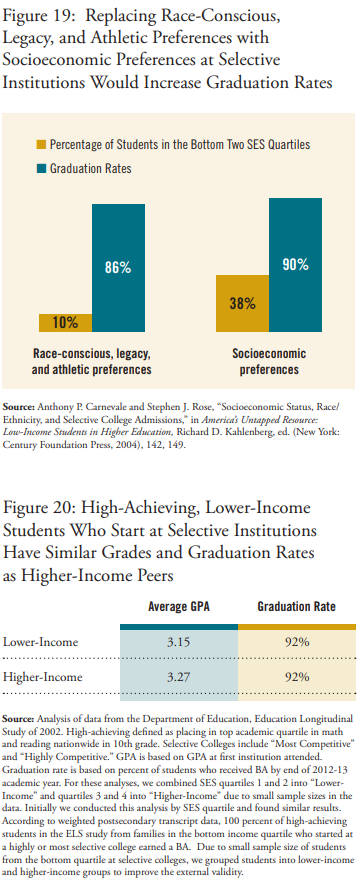
Racial Diversity
Should the Supreme Court rule that race-conscious affirmative action is unconstitutional, institutions will need to look to other strategies to maintain racial and ethnic diversity on their campuses. Recognizing the strength of high-achieving, low-income students in admissions can produce as much or more racial and ethnic diversity as current race-conscious affirmative action policies.93 Indeed, the majority of institutions which have created race-neutral strategies in response to bans on race-conscious affirmative action were able to replicate earlier levels of African American and Latino representation achieved using race as a factor in admissions.94
The experience of the Cooke Foundation further bears out that selection of high-achieving, low-income students can produce ethnic and racial diversity while maintaining or actually improving academic selectivity. Cooke Scholarships are awarded based on academic merit, leadership, commitment to others, and financial need. Characteristics such as gender, race, and ethnicity are not considered in the selection process. Yet the resulting pool of Cooke Scholars is diverse across these categories (Figure 21). The Cooke Foundation’s experience suggests that a race-blind system of selection focused on high-achieving, economically disadvantaged students, can yield high levels of racial diversity.
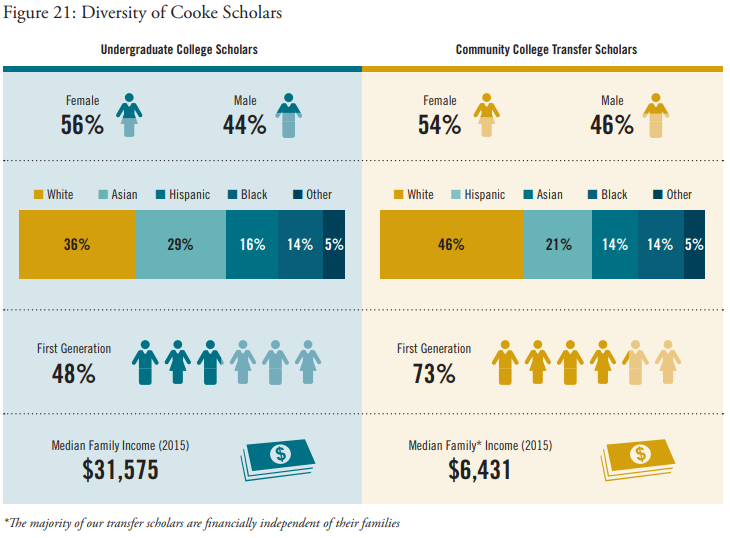
Conclusion
Representation of low-income students at selective colleges has not changed appreciably in ten years despite selective institutions’ well-advertised, increased commitment to “need-blind admissions” and “no-loan financial aid” packages. We conclude the rhetoric is empty and that admissions policies have not kept pace with either increasing capacity of low-income students or their growing numbers. All the while, the value of attending a selective college or university is clear, including higher graduation rates, higher pay for the individual, and greater productivity for the country. This makes the failure to secure admissions of so many deserving low-income students all the more disturbing. The Supreme Court’s likely further circumscription of race-conscious admission—by limiting affirmative action—is likely to exacerbate this situation unless action is taken.
The underrepresentation of high-achieving, low-income students is in large part the result of admissions practices utilized by selective colleges and universities that—presumably inadvertently— advantage privileged, wealthy students. Specifically, college and university admissions preferences provide advantages to athletes, children of alumni, and mediocre but full-paying students. Institutions compound the problem by giving advantages to students who visit the campus (which few low-income applicants can afford), apply early (which low-income students who must weigh aid packages in making college selection decisions cannot do), take the SAT or ACT multiple times and submit only their best scores (which is unavailable to low-income students who will be afforded a single fee waiver), and who do so after having been thoroughly coached (which few low-income students can afford). Additionally, low-income students tend not to have been exposed to college-level work or take AP/IB courses, which because of “weighting” by the high schools artificially inflates their GPA. Finally, the increasing reliance of standardized test scores in compiling an Academic Index to screen applications—so as not to overwhelm admissions officers with otherwise having to read thousands of applications—may unfairly eliminate disproportionate numbers of low-income students on the basis of small score differences, which we know are not predictive of college performance or indicative of any differences in ability.
The situation is not helped by the relatively small number of low-income students who actually apply to the highly selective colleges. Many more low-income students are qualified to apply in light of their capacity, records of achievement, and perseverance than actually do. As we have seen, many low-income students do not apply out of fear they cannot afford college or because they do not know that they qualify for an application fee waiver or substantial financial aid. This lack of knowledge is compounded when high school counselors discourage low-income applicants from even considering selective schools.
The good news is that when high-achieving, low-income students are admitted to selective institutions despite the barriers that have been erected, they excel. Yet relatively few are admitted because in the interest-group admissions regime of America’s selective colleges and universities, high-achieving, low-income students are the forgotten population. We conclude that these young people have enormous potential, yet are bypassed in a system that honors legacy and wealth more than hard work and talent.
For 14 years, the Cooke Foundation has supported hundreds of talented students, chosen without reference to gender, race, ethnicity, or citizenship—only intellectual ability and financial need. Now, as the U.S. Supreme Court contemplates the future of affirmative action and low-income students have overtaken other students as the majority of K-12 enrollment, the moment is ripe for colleges and universities to admit applicants on the basis of true merit at scale.
Many public institutions, having abandoned race-conscious affirmative action, are already well on their way to providing a low-income preference in their application process. They are providing a pathway for other selective higher education institutions that wish to offset the impact of poor high school college advising, unfair preferences, and inherent process advantages.
The Supreme Court’s consideration of affirmative action in college admissions provides an opportunity to review the entire system of selective college admissions. Many of the strategies that have been tested in states that have abandoned race-conscious admissions are available to institutions in the rest of the country. In particular, we believe that an approach that recognizes not only academic achievement but also the extraordinary accomplishment of low-income students who are competitive at a high level—without the plethora of supports that were provided to their wealthier peers—is much fairer because it recognizes their true merit.
When high-achieving, low-income students are admitted to selective institutions despite the barriers that have been erected, they excel.
Yet relatively few are admitted. In the interest-group admissions regime of America’s selective colleges and universities, high-achieving, low-income students are the forgotten population.
To increase access for high-achieving, low-income students, selective institutions should implement a preference for high-achieving, low-income students, to recognize these students’ true merit.
President Obama articulated the relationship between race and income in 2007, shortly after declaring his candidacy for the presidency.95
I think that my daughters should probably be treated by any admissions officer as folks who are pretty advantaged, and I think that there’s nothing wrong with us taking that into account as we consider admissions policies at universities. I think that we should take into account white kids who have been disadvantaged and have grown up in poverty and shown themselves to have what it takes to succeed. So I don’t think those concepts are mutually exclusive. I think what we can say is that in our society, race and class still intersect … and that we all have an interest in bringing as many people together to help build this country. (emphasis supplied)
A college admissions system that provides preferences for a president’s daughter— notwithstanding the president’s own rejection of that preferential system—needs to be the subject of careful scrutiny. It is difficult to justify the interaction of affirmative action, legacy, and athletic preferences, as well as the advantages conferred by visiting the campus and applying early decision that benefit a president’s daughter (in applying to her mother’s alma mater), when a child of poverty with similar standardized test scores nonetheless gets no preferences at all. This is not a level playing field, much less “need blind” admissions. It is a system that fails to appreciate the significance of the distance traveled, and it constitutes an unjustified bias against poor and minority applicants— however inadvertent—masquerading as fairness.
Scholar Profiles
Opening Doors through Advising
Samuel J. is from a small city in Wisconsin. He was raised by his father, a high
school graduate; his mother died when he was five years old. His father worked as
a self-employed remodeler with an annual gross income less than $10,000 in 2003.
Until 8th grade Sam was homeschooled, as his father feared that the public school
system could not meet Sam’s advanced educational needs. With the guidance of his
educational adviser at the Cooke Foundation, Sam enrolled in his local public high
school, simultaneously also taking online courses offered by Stanford University and
Northwestern University. With the Cooke Foundation’s guidance and financial support,
Sam attended summer programs throughout high school at University of Oxford
and Northwestern’s Center for Talent Development. Sam graduated high school in
2007 with a 4.0 GPA. He received the Cooke College Scholarship and enrolled at
Northwestern University where he triple majored in philosophy, cognitive science, and
film studies. He graduated with high honors in 2011, earning his bachelor’s degree
and a 3.88 GPA. The following year, with a Cooke graduate award, he enrolled at Yale
University where he is currently pursuing his Ph.D. in cognitive psychology.
Emerging from Challenge Ready to Serve
“My life has truly been one of struggle, but that has served as my motivation.” Raised
by a single mother, Samantha P. (Sam) and her younger sister were accustomed to
frequent moves. They lived in four different locations between middle and high schools.
Her mom worked at a car dealership struggling to make ends meet. Sam was chosen as
a Cooke Young Scholar in 7th grade. Throughout high school, Sam worked up to 30
hours per week at a movie theater to help pay the family’s bills. At the independent allgirls
high school she attended in Memphis, Tennessee, Sam started a chapter of Project
Teen Race to address issues of diversity and help others find self-acceptance. She led the
track squad, interned at St. Jude Children’s Research Hospital, and spent two summers
studying philosophy and psychology at the University of Kansas. Her senior year, Sam
became a National Achievement Finalist and was inducted into Mu Alpha Theta, the
mathematics honor society. In 2011 she enrolled at New York University (with Cooke
scholarship support), where she majored in applied psychology and minored in creative
writing and global and urban education studies. While at NYU, Sam founded and
directed a startup nonprofit that targets mental health in education and served as the
editor and executive director of the NYU Online Publication of Undergraduate Studies.
She also interned with NYC ROSES Project, where she served as an advocate for a
girl in the juvenile justice system, and studied abroad in Florence, Italy. She graduated
magna cum laude in spring 2015 with a 3.86 GPA. Not only was Sam accepted early
into the 2015-2016 Teach for America cohort, but she was also selected as one of 50
Equity Fellows.
Taking a Nontraditional Path to Excellence
Melissa O. dropped out of high school at the age of 14. She set out with no family support
of her own, and took a job earning minimum wage to support herself. She became a mother
at the age of 19. Twelve years after dropping out of high school, at age 26, she enrolled
at Umpqua Community College and fell in love with sociology. She was president of the
student government at Umpqua and advocated for fellow students in a variety of ways,
including creating an advocacy group in response to student hunger that enabled her, in her
words, “to aid my fellow students and help them focus on their education” instead of their
hunger. Melissa was named to USA Today’s All-USA Community College Academic Team,
chosen as a Coca-Cola Foundation New Century Scholar, and the Oregon Community
College Association Outstanding Scholar in her graduating year. She graduated from
community college with a 3.89 GPA. Receipt of the Cooke Foundation’s Undergraduate
Transfer Scholarship allowed Melissa to transfer to Reed College, where she did work
investigating the lived experience of prisoner reentry and also received a competitive research
grant to do public policy based on research focused on a comparative historical analysis of
government contracted military organizations. Throughout her three years at Reed, Melissa
mentored freshmen from underrepresented backgrounds and founded a program to support
non-traditional students while maintaining a 3.86 GPA. After graduating with her B.A. in
sociology, Melissa enrolled in a doctoral program at the University of Chicago. Her research
spans the areas of identity, social mobility, and inequality, and her doctoral research is a
comparative ethnographic project that juxtaposes the experiences of individuals entering
homelessness for the first time with first generation college students entering elite institutions
of higher education. In addition to this project, Melissa does research and policy work tied
to the legal control and policing of marginalized groups and has recently published an article
in the Annual Review of Law and Social Science on the topic. She is actively engaged in
education outreach with youth and adult homeless populations in the Chicago area.
Pursuing America’s Promise
Larry L. is a first generation college student. His parents immigrated to this country
when he was in high school, finding jobs that together earned them less than $1,000
annually. Without knowledge or guidance of the American system of higher education,
Larry enrolled in community college following his high school graduation. While at
community college, Larry served as a student ambassador, helping freshmen students
during orientation, recruiting students from low-income communities to enroll
in community college, and lobbying state legislators to maintain funding for the
community college. In addition, he was a staff writer for the student newspaper, a
member of Phi Theta Kappa (an international honor society for community college
students), and a recipient of two scholarships. He became a member of the honors
college and ultimately graduated with a 4.0 GPA. Becoming a Cooke Undergraduate
Transfer Scholar allowed him to transfer to the University of Pennsylvania where he
collaborated with professors on research topics ranging from the college skills gap
to technological displacement effects in retail and the rise of right-wing populism in
Europe. Ultimately he graduated summa cum laude with a 3.81 GPA and a B.A. in
sociology and a minor in economic policy. With the Cooke Foundation’s graduate
award support, he is now enrolled at the University of Oxford where he is pursuing
a M.Sc. in comparative social policy. Once complete, he will return to Princeton
University to pursue a Ph.D. in sociology.
Learning through Experience
Will T. grew up with his mother and two older siblings. His mother, an accountant
earning just under $40,000, had worked full time and taken night classes while Will
was young to earn a master’s degree. At the time of application to the Young Scholars
Program, Will aspired to attend his local magnet school for science and technology
but was unsure how to navigate the competitive admissions process in which less
than 20 percent of applicants were admitted. The following year, with the help of his
Cooke educational adviser, Will submitted an application and was accepted. During
his summers in high school, he attended a service learning program in Ethiopia, and
a chemical engineering program at the University of Connecticut. Will credits these
summer experiences with igniting his passion for using science to address social issues
in developing countries. Will graduated with a 4.0 GPA from the magnet high school
and continued on with the Cooke Foundation’s support to Stanford University. There
he majored in chemical engineering and minored in African studies, graduating in 2012
with a 3.85 GPA. The foundation now supports his graduate work at the University
of California, Berkeley, as an environmental engineering Ph.D. student focusing on
sanitation in the developing world. Reflecting on his experience as a Cooke Scholar,
Will said, “I have literally grown up with the foundation. I found myself able to do
things I had always dreamed of but never thought possible, like taking private cello
lessons, attending CTY to study math, logic, and cryptology, and traveling to Ethiopia
through LearnServe. Every single one of these experiences played a fundamental role
in shaping me into the person I am today. Most significantly, my journey to Ethiopia
was the spark that ignited my passion for water and sanitation in the developing world,
which has become the primary focus of my studies. Because of my firsthand experiences
with people, places, and issues in the developing world, I sought out technical prowess
and a humanities perspective to ask questions about what development is and how to
make it happen.”
Appendices
Appendix A
Barron’s Classifications of Higher Education Institutions
Most Competitive:
There were 91 institutions classified as “Most Competitive” in 2015. In general, these colleges require high school rank in the top 10% to 20% and grade averages of A to B+. Median freshman test scores at these colleges are generally between 655 and 800 on the SAT and 29 and above on the ACT. In addition, many of these colleges admit only a small percentage of those who apply—usually fewer than one third.
Examples: Amherst College, Harvard University/Harvard College, University of Chicago
Highly Competitive:
There were 102 institutions classified as “Highly Competitive” in 2015. Colleges in this group generally look for students with grade averages of B+ to B and accept most of their students from the top 20% to 35% of the high school class. Median freshman test scores at these colleges generally range from 620 to 654 on the SAT and 27 or 28 on the ACT. These schools generally accept between on third and one half of their applicants.
Examples: Drexel University, Stony Brook University/State University of New York, University of Michigan – Ann Arbor
Very Competitive:
There were 308 institutions classified as “Very Competitive” in 2015. The college is this category generally admit students whose averages are no less than B- and who rank in the top 35% to 50% of their graduating class. They generally report median freshman test scores in the 573 to 619 range on the SAT and from 24 to 26 on the ACT. These schools generally accept between one half and three quarters of their applicants.
Examples: Florida Institute of Technology, University of Mary Washington, Quinnipiac University
Competitive:
There were 641 institutions classified as “Competitive” in 2015. This category is a very broad one, covering colleges that generally have median freshman test scores between 500 and 572 on the SAT and between 21 and 23 on the ACT. Some of these colleges require that students have high school averages of B- or better, although others state a minimum of C+ or C. Generally, these colleges prefer students in the top 50% to 65% of the graduating class and accept between 75% and 85% of their applicants.
Examples: California State University—Long Beach, Indiana State University, University of South Dakota
Less Competitive:
There were 187 institutions classified as “Less Competitive” in 2015. Included in this category are colleges with median freshman test scores generally below 500 on the SAT and below 21 on the ACT; some colleges that require entrance examinations but do not report median scores; and colleges that admit students with averages generally below C who rank in the top 65% of the graduating class. These colleges usually admit 85% or more of their applicants.
Examples: Chestnut Hill College, Northwood University, Texas A&M University—Corpus Christi
Noncompetitive:
There were 57 institutions classified as “Noncompetitive” in 2015. The colleges in this category generally only require evidence of graduation from an accredited high school (although they may also require completion of a certain number of high school units). Some require that entrance examinations be taken for placement purposes only, or only by graduates of unaccredited high schools or only by out-of-state students. In some cases, insufficient capacity may compel a colleges in this category to limit the number of students that are accepted; generally, however, if a colleges accepts 98% or more of its applications, it automatically falls in this category. Colleges are also rated Noncompetitive if they admit all state residents, but have some requirements for nonresidents.
Examples: Kaplan University, Northwest Nazarene University, University of Nevada—Reno
Special: There were 76 institutions classified as “Special” in 2015. Listed here are colleges whose programs of study are specialized; professional schools of art, music, nursing, and other disciplines. In general, the admissions requirements are not based primarily on academic criteria, but on evidence of talent or special interest in the field. Many other colleges and universities offer special-interest programs in addition to regular academic curricula, but such institutions have been given a regular competitive rating based on academic criteria. Schools oriented toward working adults have also been assigned this rating.
Examples: California Institute of the Arts, Rhode Island School of Design, Westminster Choir College
Appendix B
Primary Data Sources
This report presents original research from four primary data sources: institution and student-level data from the Department of Education; student-level data from the Common Application; and student-level data on Cooke Scholars maintained by the Cooke Foundation.
Classification of Selectivity
Selectivity measures used in institution-level and student-level analyses are based on Barron’s Profile of American Colleges. All analyses of federal data (IPEDS and ELS) used the 2004 classifications. All analyses of Cooke Scholar data used the 2015 classifications. Appendix A provides more detail on the categories.
United States Department of Education, Integrated Postsecondary Education Data System (IPEDS)
Institution-level data were derived from the Integrated Postsecondary Education Data System (IPEDS). Each observation represents a Title IV institution, which is identified by the six-digit Office of Postsecondary Education identification variable (OPEID). A Title IV institution is a postsecondary institution authorized to enroll students receiving Title IV federal financial aid (e.g., Pell). IPEDS data collected at the Title IV campus-level were aggregated to the Title IV institution-level prior to merging data from different IPEDS survey components. For institutional characteristics that cannot be aggregated across Title IV campuses (e.g., Barron’s selectivity), we used the characteristics associated with the “main” campus that enters into the Program Participation Agreement with the federal government. For example, Rutgers University is a three-campus (New Brunswick, Newark, Camden) Title IV institution. New Brunswick holds the Program Participation Agreement. In the analysis dataset, percent fulltime freshman Pell recipients is calculated as total freshman Pell recipients divided by total freshman headcount across all three campuses, but Barron’s selectivity is defined as the value associated with the New Brunswick campus. See Jaquette and Parra (2014) for additional details about constructing panel datasets from IPEDS.96 Data from U.S. military academies were dropped from these analyses (U.S. Air Force Academy; U.S. Coast Guard Academy; U.S. Naval Academy; U.S. Military Academy; U.S. Merchant Marine Academy).
United States Department of Education, Education Longitudinal Study of 2002 (ELS)
Student-level data were derived from the Education Longitudinal Study of 2002 (ELS) restricted use base year, follow-up wave 1, follow-up wave 2, follow-up wave 3, and college transcript data. These data were used to examine the postsecondary access and success of high-achieving, low-income students who were in Grade 10 in 2002. Students not part of the initial survey were excluded from our analyses, as were students who did not complete high school, and students for which the date of high school completion is unknown. Students for which no transcripts were received were also removed from the analyses.
Whenever possible the analyses were conducted using transcript data (not survey data). For this report, we used the Education Longitudinal Study of 2002 (ELS) transcript data from the “PETS_ student_institution” file to identify the colleges and universities students attended, college GPA data, and any postsecondary degrees received. The “Student_Institution-F2” file was also used to identify which schools they applied to.
We define “high-achieving” as those students who scored in the top 25 percent on the 10th grade standardized exams. We grouped students into quartiles on their 10th grade standardized test score for a composite of math and reading testing. Students’ economic background was identified using a composite measure of SES created by the Department of Education that reflects the student’s family income, mother’s education, father’s education, mother’s occupation, father’s occupation, and household goods. Analyses utilized probability weights to produce results that were representative of the population. The weight variable used varied depending on the data sources used in the specific analysis.
Common Application
Data from the applications submitted by high-achieving students in the 2013-14 application year through the Common Application were analyzed to answer questions about use of fee waivers and frequency of early admissions. High-achieving was defined as having reported a top decile score on the SAT (critical reading and mathematics combined) or the ACT (composite). Family income was estimated by Experian Data Quality based on student’s home address.
Appendix C
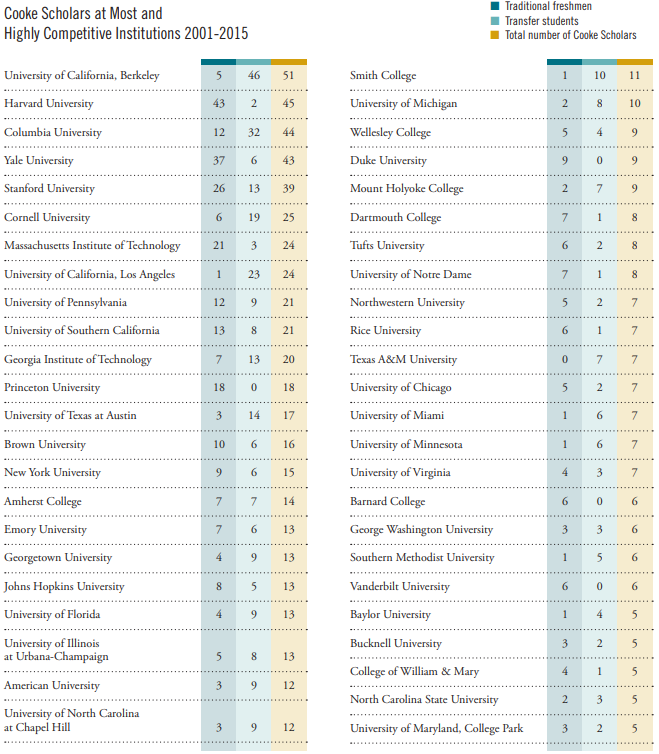
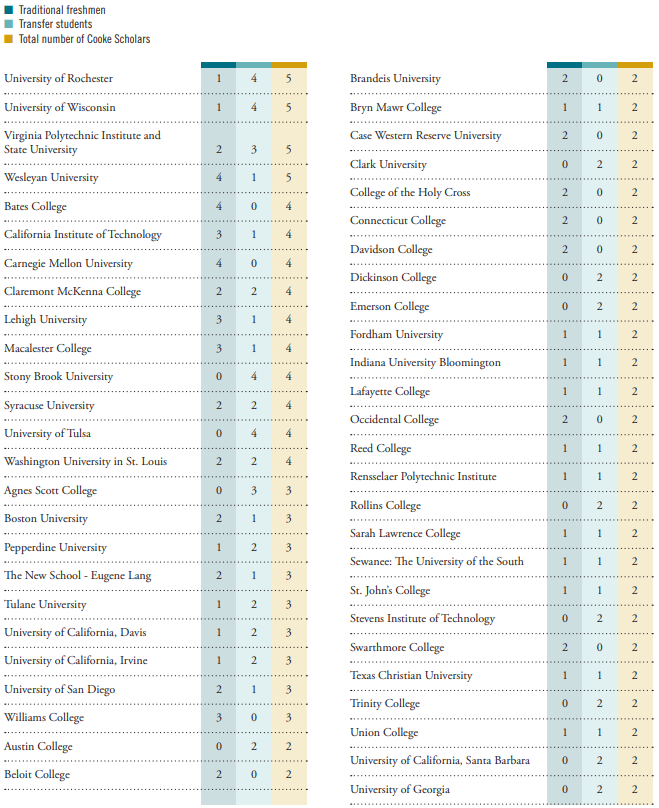
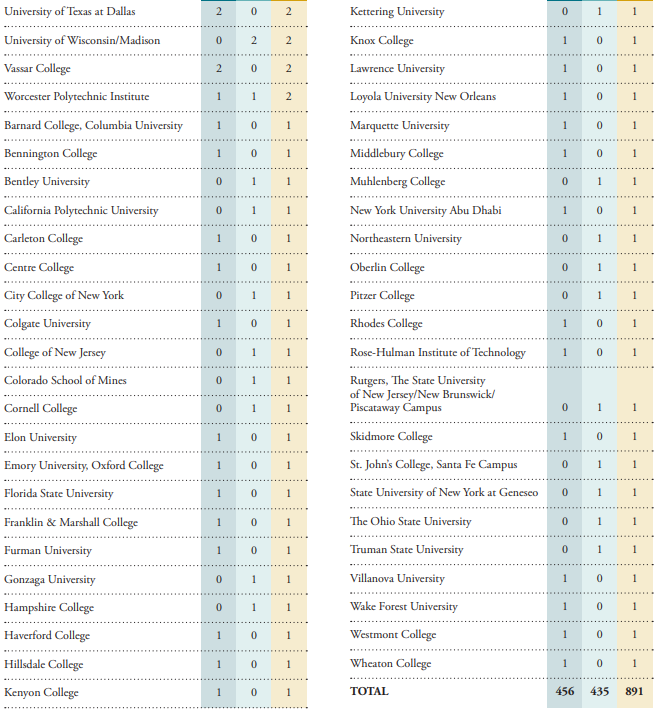
Endnotes
1 See Figure 1, page 5. Our analyses use the latest transcript data file from the Education Longitudinal Survey, and confirm earlier versions of these analyses reported by Michael N. Bastedo and Ozan Jaquette, “Institutional Stratification and the Fit Hypothesis: Longitudinal Shifts in Student Access,” Paper presented at the Annual Meeting of the Association for the Study of Higher Education (Vancouver, British Columbia, November 4-7, 2009).
2 See Figure 4, page 8. For these purposes, we define “high-achieving” as those scoring in the top academic quartile in 10th grade.
3 On June 24, 2013, by a vote of 7-1, the Supreme Court ruled that the lower court had not applied a sufficiently demanding legal standard when it upheld the use of race in selecting entering classes and that the University had the burden “to prove that its admissions program is narrowly tailored to obtain the educational benefits of diversity.” 570 US (slip op., at 13). The Fifth Circuit announced its decision in favor of the University on July 15, 2014. The Supreme Court said that it would hear another challenge to the University’s admissions policy on June 29, 2015. Docket No. 14-981.
“If the policy does not meet this standard, race may not be considered in the admissions process. The Court held that it was the duty of the reviewing court to “verify” that the University policy in question was necessary to achieve the benefits of diversity and that no race-neutral alternative would provide the same benefits. The Supreme Court held that the lower courts did not conduct a sufficient strict scrutiny examination in this case.” Oyez blog post (IIT Chicago-Ken College of Law). https://www.oyez.org/ cases/2012/11-345
4 For students from the high school senior class of 1992, for example, students from the bottom socio-economic quartile made up 5.0% of students enrolled at most competitive institutions and 6.4% of students enrolled in highly competitive institutions. Michael N. Bastedo and Ozan Jaquette, “Running in Place: Low-Income Students and the Dynamics of Higher Education Stratification,” Educational Evaluation and Policy Analysis, Vol. 33, No 3 (September 2011), Appendix Table 6. Likewise, among the 35 Coalition on Financing Higher Education (COFHE) schools, all of which are highly selective liberal arts colleges or universities, students from the bottom 40 percent of income distribution in the United States make up only ten percent of the enrolled student body. Catharine B. Hill, Gordon C. Winston, and Stephanie Boyd, “Affordability: Family Incomes and Net Prices at Highly Selective Private Colleges and Universities,” Journal of Human Resources 40, No. 4 (Fall 2005), pp. 769-790. COFHE schools include Amherst, Bryn Mawr, Barnard, Brown, Carleton, UChicago, Columbia, Cornell, Dartmouth, Duke, Georgetown, Harvard, Johns Hopkins, Mt. Holyoke, MIT, Northwestern, Oberlin, UPenn, Pomona, Princeton, Rochester, Rice, Smith, Stanford, Swarthmore, Trinity, Washington University in St. Louis, Wellesley, Wesleyan, Williams, and Yale. Three of these schools did not participate in the research study.
5 See, for example, many pledges by selective institutions to increase access for low-income students at the White House’s convening on college opportunity. The White House, “Commitments to action on college opportunity” (Washington, D.C.: The Executive Office of the President, 2014).
6 As part of the American Recovery and Reinvestment Act of 2009, the maximum Pell award amount increased from $4,730 to $5,350 and the federal government also increased Pell funding. Total federal expenditure on Pell increased from $19.8 billion in 2008-09 to $33.2 billion in 2009-10 to $39.0 billion in 2010-11, but fell to $35.4 billion in 2011-12 and to $33.3 billion in 2012-13.
7 College Board, “Trends in student aid, 2015” (New York, NY: College Board, 2015). Also, New America Foundation, “Background and Analysis, Federal Pell Grant Program” (2014). http://febp.newamerica.net/background-analysis/federal-pellgrant-program
8 Josh Zumbrun, “SAT Scores and Income Inequality: How Wealthier Kids Rank Higher,” The Wall Street Journal, October 7, 2014. Also, Zachary A. Goldfarb, “These four charts show how the SAT favors rich, educated families,” The Washington Post, March 5, 2014.
9 Caroline M. Hoxby and Christopher Avery, The Missing “One-Offs”: The Hidden Supply of High-Achieving, Low Income Students, National Bureau of Economic Research Working Paper 18586, 2012.
10 Catharine B. Hill and Gordon C. Winston, “How Scarce Are High-Ability, Low-Income Students?” in College Access: Opportunity or Privilege? edited by Michael S. McPherson and Morton Owen Schapiro (New York, NY: The College Board, 2006).
11 Hoxby and Avery (2012); Alexandria Walton Radford, Top Student, Top School? How Social Class Shapes Where Valedictorians Go to College (Chicago, IL: University of Chicago Press, 2013); The White House, “Increasing College Opportunity for Low-Income Students: Promising Models and a Call to Action” (Washington, D.C.: The Executive Office of the President, 2014).
12 David Leonhardt, “Better Colleges Failing to Lure the Talented Poor,” New York Times, March 16, 2013.
13 See, for example, Frank Bruni, Where You Go is Not Who You’ll Be: An Antidote to the College Admissions Mania (New York, NY: Grand Central Publishing, 2015).
14 After controlling for SAT scores, Carnevale and Rose found that students attending more selective colleges were more likely to attend graduate school than those attending less selective colleges. Anthony P. Carnevale and Stephen J. Rose, “Socioeconomic Status, Race/ Ethnicity, and Selective College Admissions,” in America’s Untapped Resource: Low-Income Students in Higher Education, edited by Richard D. Kahlenberg (Washington, D.C.: Century Foundation, 2004), p. 111.
15 According to Cooke Foundation staff research, faculty members at the top 193 institutions in America have received over 200 Nobel prizes, representing 24 percent of all prizes awarded since 1901.
16 Robert H. Frank and Philip J. Cook, The winner-take-all society: how more and more Americans compete for ever fewer and bigger prizes, encouraging economic waste, income inequality, and an impoverished cultural life (New York, NY: Free Press, 1995).
17 The institutions are: Harvard, Yale, Stanford, Columbia, MIT, Cornell, Chicago, Northwestern, Princeton, Johns Hopkins, UPenn, and UC Berkeley. Thomas Dye, Who’s Running America? (Boulder, CO: Paradigm Publishers, 2014), p. 180, Table 1.2.
18 Jonathan Smith, Matea Pender, and Jessica Howell, “The full extent of student-college academic undermatch,” Economics of Education Review (2013), 32, pp. 247-261.
19 Analysis of applications submitted by high school seniors to the Cooke College Scholarship and community college students to the Cooke Undergraduate Transfer scholarship in 2014 and 2015. “Selective” defined as institutions classified as “Most Competitive” or “Highly Competitive” in Barron’s. Fewer transfer students list a selective school among their top three choices (54%) than the high school seniors (73%).
20 William R. Fitzsimmings, “Guidance Office: Answers from Harvard’s Dean, Part 1,” New York Times, September 10, 2009.
21 William G. Bowen, Martin A. Kurzweil, and Eugene M. Tobin, Equity and Excellence in American Higher Education (University of Virginia Press, 2005), p. 99, Figure 5.1.
22 Hoxby and Avery (2012), p. 6.
23 Hill, Winston, and Boyd (2005).
24 Analysis conducted for this report by Dr. Daniel Hae-Dong Lee and Evan Hodges-LeClaire, Censeo Consulting Group, of 2013- 14 applications submitted through the Common Application. Family income estimated by Experian Data Quality based on student’s home address. High-achieving defined as having reported a top decile score on the SAT (critical reading and mathematics combined) or the ACT (composite).
25 Radford (2013), pp. 1-2.
26 Laura W. Perna, Valerie Lundy-Wagner, April Yee, Leykia Brill, and Teran Tadal, “Showing them the money: The role of institutional financial aid policies and communication strategies in attracting low-income students,” in Recognizing and serving low-income students in higher education: an examination of institutional policies, practices, and culture, edited by A. J. Kezar (New York, NY: Routledge, 2010), pp. 72-96.
27 Caroline M. Hoxby and Sarah Turner, “Expanding College Opportunities for High-Achieving, Low-income Students,” Discussion Paper No. 12-014 (Stanford, CA: Stanford Institute for Economic Policy Research, 2013).
28 Benjamin L. Castleman, The 160-Character Solution: How Text Messaging and Other Behavioral Strategies Can Improve Education (Baltimore, MD: Johns Hopkins Press, 2015).
29 Analysis of data from the Department of Education’s, Education Longitudinal Study of 2002.
30 Alexandria Walton Radford and Jessica Howell, “Addressing Undermatch: Creating Opportunity and Social Mobility,” in The Future of Affirmative Action, edited by Richard D. Kahlenberg (Washington, D.C.: Century Foundation, 2014) pp. 133-144.
31 Radford (2013), p. 31, Table 2.1.
32 http://advisingcorps.org/our-work/mission-history/
33 Jennifer L. Stephan and James E. Rosenbaum, “Can High Schools Reduce College Enrollment Gaps With a New Counseling Model?” Educational Evaluation and Policy Analysis (2013), 35(2), pp. 200-219.
34 See http://www.coalitionforcollegeaccess.org/ and www.commonapp.org/ready.
35 Author email exchange with Abigail Seldin, VP, Innovation & Product Management, ECMC Group.
36 Eric Hoover, “Application Inflation: When is Enough Enough?” New York Times, November 5, 2010.
37 https://admission.princeton.edu/applyingforadmission, page viewed October 21, 2015.
38 Ivy Coach, https://www.ivycoach.com/2019-ivy-leagueadmissions-statistics/. Confirmed by author conversation with Yale admissions officer James Kim, October 16, 2015.
39 http://www.businessinsider.com/why-ivy-league-admissions-willgoogle-you-2013-9
40 Rachel B. Rubin, “Who Gets In and Why? An Examination of Admissions to America’s Most Selective Colleges and Universities,” International Education Research, 2(2) (Science and Education Centre of North America, 2014).
41 Only 5.5% of low-income students in high schools with AP/ IB courses take them, compared with 15.6% of other students. Christina Theokas and Reid Saaris, Finding America’s Missing AP and IB Students (Washington, D.C.: The Education Trust, 2013).
42 One service, “Prepscholar,” reports that a 4.4 GPA means a student’s average is higher than 99.93% of other schools. http:// blog.prepscholar.com/weighted-vs-unweighted-gpa-whatsthe-difference
43 Sigal Alon, “The Evolution of Class Inequality in Higher Education: Competition, Exclusion, and Adaptation,” American Sociological Review (2009), 74(5), pp. 731-755.
44 National Association for College Admission Counseling, State of College Admission annual report (2007, 2014).
45 http://www.usnews.com/education/best-colleges/articles/how-usnews-calculated-the-rankings?page=3
Data for 2010 reported in: Rob Bielby, Julie Renee Posselt, Ozan Jaquette, and Michael N. Bastedo, “Why are Women Underrepresented in Elite Colleges and Universities? A Non-Linear Decomposition Analysis,” Research in Higher Education (New York, NY: Springer, 2012).
http://www-personal.umich.edu/~bastedo/papers/ BielbyPosseltJaquetteBastedo.pdf
46 Amanda Griffith and Kevin Rask, “The Influence of U.S. News and World Report Collegiate Rankings on the Matriculation Decision of High-Ability Students: 1995-2004” (Cornell University Higher Education Research Institute, September 2005).
47 Carnevale and Rose (2004), p. 139
48 Jennifer L. Kobrin and Rochelle S. Michel, The SAT As a Predictor of Different Levels of College Performance, Research Report No. 2006- 3 (New York, NY: College Board, 2006).
49 “SAT Coaching Found to Boost Scores—Barely,” Wall Street Journal (May 20, 2009; sourced online November 22, 2015) at http://www.wsj.com/articles/SB124278685697537839
http://www.marketwatch.com/story/10-things-testprep-serviceswont-tell-you-1301943701454
50 Ben Dominque and Derek C. Briggs, “Using Linear Regression and Propensity Score Matching to Estimate the Effect of Coaching on the SAT” (Paper presented at the University of Colorado May 20, 2009) (Coaching was found to be more effective for students who had taken “challenging academic coursework and come from high socioeconomic backgrounds”).
http://www.colorado.edu/education/sites/default/files/attachedfiles/Domingue_Briggs_Using%20Propensity%20Score%20 Matching.pdf
51 William G. Bowen, Matthew M. Chingos, and Michael S. McPherson, Crossing the Finish Line: Completing College at America’s Public Universities (Princeton, NJ: Princeton University Press, 2009), p. 131.
52 Andrew S. Belasco, Kelly O. Rosinger, and James C. Hearn, “The Test-Optional Movement at America’s Selective Liberal Arts Colleges: A Boon for Equity or Something Else?” Educational Evaluation and Policy Analysis (June 12, 2014).
53 Melissa Clinedinst, 2014 State of College Admission (Arlington, VA: National Association for College Admission Counseling, 2015), p. 30, Table 18.
54 Christopher Avery, Andrew Fairbanks, and Richard Zeckhauser, The Early Admissions Game: Joining the Elite (Cambridge, MA: Harvard University Press, 2003), p. 150.
55 Analyses conducted for this report by Dr. Daniel Hae-Dong Lee and Evan Hodges-LeClaire, Censeo Consulting Group. Analysis examined all applications submitted in 2013-14 by high-achieving students. Students were considered high-achieving if they reported an SAT (out of a possible 1600 combined math and verbal) or ACT Composite score at the 90th percentile or above. Income predictions provided by Experian Data Quality.
56 Richard D. Kahlenberg, “The Restoration of Early Admissions,” The Chronicle of Higher Education (February 25, 2011).
57 Harvard University states on its website, for example, “Our scholarships are based entirely on need, not merit.” https://college. harvard.edu/financial-aid/types-aid
58 Edward B. Fiske, “Gaining Admission: Athletes Win Preference,” New York Times January 1, 2001.
59 Daniel Golden, The Price of Admission: How America’s Ruling Class Buys Its Way into Elite Colleges—and Who Gets Left Outside the Gates (New York, NY: Crown Publishing, 2006).
60 James L. Shulman and William G. Bowen, The Game of Life: College Sports and Educational Values (Princeton, NJ: Princeton University Press, 2002).
61 Bowen, Kurzweil, and Tobin (2005), p. 105, Table 5.1.
62 Patricia Gurin, Biren A. Nagda, and Gretchen Lopez, “The Benefits of Diversity in Education for Democratic Citizenship,” Journal of Social Issues, September 2, 2002. Patricia Gurin, Eric L. Dey, Sylvia Hurtado, and Gerald Gurin, “Diversity and Higher Education: Theory and Impact on Educational Outcomes,” Harvard Educational Review (Cambridge, MA: 2002). Patricia Gurin, “The Compelling Need for Diversity in Education,” January 1999. Expert report prepared for the lawsuits Gratz and Hamacher v Bollinger, Duderstadt, the University of Michigan, and the University of Michigan College of LS&A, U.S. District Court, Eastern District of Michigan, Civil Action No. 97-75231; and Grutter v Bollinger, Lehman, Shields, the University of Michigan and the University of Michigan Law School, U.S. District Court, Eastern District of Michigan, Civil Action No. 97-75928.
63 Grutter v Bollinger, 539 U.S. 306, 324 (2003). See also Endnote 3.
64 Sean F. Reardon, “The Widening Academic Achievement Gap Between the Rich and Poor: New Evidence and Possible Explanations,” in Whither Opportunity? Rising Inequality, Schools, and Children’s Life Chances, edited by Greg J. Duncan and Richard J. Murnane (Russell Sage Foundation and Spencer Foundation, 2011).
65 William G. Bowen and Derek Bok, The Shape of the River: Long-Term Consequences of Considering Race in College and University Admissions (Princeton, NJ: Princeton University Press, 1998), p. 341, Table B.2.
66 https://www.edvisors.com/plan-for-college/college-admissions/ need-blind-admissions/
67 W.R. Doyle, “Changes in institutional aid, 1992-2003: The evolving role of merit aid,” Research in Higher Education (2010), 51(8), pp. 789-810.
68 Stephen Burd, “Merit Aid Madness,” Washington Monthly (September/October 2013). http://www.washingtonmonthly. com/magazine/september_october_2013/features/merit_aid_ madness046453.php?page=all
69 In some cases, legacy preferences are also extended to other relatives, particularly when the alumnus is a wealthy donor or someone who holds out the prospect of making a substantial gift to the institution. Michael Hurwitz, “The impact of legacy status on undergraduate admissions at elite colleges and universities,” Economics of Education Review (2011), 30(3), pp. 480-492.
70 Leslie Killgore, “Merit and Competition in Selective College Admissions,” Review of Higher Education (2009), 32(4), pp. 469- 488. David Karen, “Toward a Political-Organizational Model of Gatekeeping: The Case of Elite Colleges,” Sociology of Education (1990), 63(4), pp. 227-240.
71 John Brittain and Eric L. Bloom, “Admitting the Truth: The Effect of Affirmative Action, Legacy Preferences and the Meritocratic Ideal on Students of Color in College Admissions,” in Affirmative Action for the Rich: Legacy Preferences in College Admission edited by Richard D. Kahlenberg (Century Foundation Press, 2010), pp. 123-142.
72 Cooke Foundation staff review of Common Data Sets from Most Competitive and Highly Competitive institutions, which found that 87% of these institutions report using legacy preferences. This confirms earlier work, which found that three-quarters of the top 100 universities used legacy preferences in 2007. Chad Coffman, Tara O’Neil, and Brian Starr, “An Empirical Analysis of the Impact of Legacy Preferences at Top Universities,” in Affirmative Action for the Rich (1976), pp. 119-121.
73 Thomas J. Espenshade, Chang Y. Chung, and Joan L. Walling, “Admissions Preferences for Minority Students, Athletes, and Legacies at Elite Universities,” Social Science Quarterly 85, no. 5 (December 2004), p. 1431.
74 http://www.thecrimson.com/article/2011/5/11/admissionsfitzsimmons-legacy-legacies/
Harvard’s rate is typical of other selective schools, where legacy applicants are two to four times as likely to be admitted as other advocates. Daniel Golden, The Price of Admission: How America’s Ruling Class Buys Its Way into Elite Colleges—and Who Gets Left Outside the Gates (New York, NY: Crown Publishing, 2006), p.122.
75 Coffman, O’Neil, and Starr (1976), pp. 101-102.
76 In one legal brief, a number of top universities claimed that they “give significant favorable consideration” to economically disadvantaged students in pursuit of SES alongside racial and ethnic diversity. Brief of Harvard University, Brown University, The University of Chicago, Dartmouth College, Duke University, The University of Pennsylvania, Princeton University, and Yale University as Amicus Curiae Supporting Respondents, U.S. Supreme Court in Grutter v. Bollinger and Gratz v. Bollinger, p. 22, n.13.
77 Bowen, Kurzweil, and Tobin (2005), p. 105, Table 5.1; Carnevale and Rose (2004), p. 135; and Thomas J. Espenshade and Alexandria Walton Radford, No Longer Separate, Not Yet Equal (2009), p. 92, Table 3.5.
78 Admissions estimates from Robert Birgeneau, chancellor of the University of California, Berkeley. Reported in Golden (2006), p. 7.
79 Golden (2006), p. 14.
80 Sheryll Cashin, Place, Not Race: A New Vision of Opportunity in America (Boston, MA: Beacon Press, 2014).
81 Jorge Klor de Alva and Mark Schneider, Rich Schools, Poor Students: Tapping Large University Endowments to Improve Student Outcomes (Chandler, AZ: Nexus Research and Policy Center, 2015), p. 1.
82 Nancy McDuff and Halley Potter, “Ensuring Diversity under Race-Neutral Admissions at the University of Georgia,” in The Future of Affirmative Action: New Paths to Higher Education Diversity after Fisher v. University of Texas edited by Richard D. Kahlenberg (New York, NY: Century Foundation Press, 2014), pp. 122-130.
83 Richard D. Kahlenberg, “Introduction,” in The Future of Affirmative Action, p. 12; and Richard Sander, “The Use of Socioeconomic Affirmative Action at the University of California,” in The Future of Affirmative Action, pp. 104-107.
84 Author conversation with Dr. Greg Dubrow, Director of Research & Policy Analysis, Office of Undergraduate Admissions, University of California, Berkeley, November 11, 2015.
85 Peter Schmidt, “Richer Data on College Applicants Help the Prospects of Low-Income Students,” The Chronicle of Higher Education, November 7, 2015.
86 Due to space constraints, the figure was subsequently reduced to 7%.
http://alcalde.texasexes.org/2012/11/txexplainer-why-top-10- percent-is-now-top-7/
and
http://admissions.utexas.edu/apply/decisions
87 Marta Tienda, “Lessons from Texas in the Aftermath of Hopwood and Fisher,” in The Future of Affirmative Action, pp. 92-97. Sunny X. Niu and Marta Tienda, “Minority Student Academic Performance under the Uniform Admission Law: Evidence from the University of Texas at Austin,” Educational Evaluation and Policy Analysis (2010), 32, p. 44.
88 Halley Potter, “Transitioning to Race-Neutral Admissions,” in The Future of Affirmative Action edited by Kahlenberg (2014), p. 85.
89 Potter, “Transitioning to Race-Neutral Admissions,” p. 87.
90 Richard D. Kahlenberg and Halley Potter, A Better Affirmative Action: State Universities that Created Alternatives to Racial Preferences (Century Foundation, 2012), pp. 56-59.
91 Carnevale and Rose (2004), pp. 148-149.
92 Note that the researchers did not advocate proportional representation—i.e., 50% of students admitted coming from the bottom SES half—because even if that percentage of students were deserving in some moral sense given the obstacles they faced, some would not all be adequately prepared for the academic rigors at selective colleges and universities.
93 Matthew Gaertner, “Advancing College Access with Class-Based Affirmative Action: The Colorado Case,” in The Future of Affirmative Action, p. 181; Also Anthony P. Carnevale, Stephen J. Rose, and Jeff Strohl, “Achieving Racial and Economic Diversity with Race-Blind Admissions Policy,” in The Future of Affirmative Action, p. 192.
94 Seven of the ten institutions that have implemented admissions practices that consider SES factors have maintained racial and ethnic diversity. These institutions are UT Austin, Texas A&M, the University of Washington, the University of Florida, the University of Georgia, the University of Nebraska, and the University of Arizona. Three institutions—UC Berkeley, UCLA, and the University of Michigan—were not able to sustain previous levels of racial diversity. But they could hardly be expected to because they compete for bright minority students with other top institutions that can continue to use racial preferences in admissions. Kahlenberg and Potter (2012), pp. 26-61.
95 Barack Obama on ABC’s “This Week with George Stephanopoulos,” May 13, 2007. http://blogs.suntimes.com/ sweet/2007/05/obama_on_abcs_this_week_with_g.html
96 Ozan Jaquette and Edna E. Parra, “Using IPEDS for Panel Analyses: Core Concepts, Data Challenges, and Empirical Applications” in Higher Education: Handbook of Theory and Research edited by M.B. Paulsen (Springer, Netherlands: 2014), Vol 29, pp. 467-533.
About the Jack Kent Cooke Foundation
The Jack Kent Cooke Foundation is dedicated to advancing the education of
exceptionally promising students who have financial need. By offering the largest
scholarships in the country, comprehensive counseling and other support services to
students from 7th grade to graduate school, the Foundation is dedicated to ensuring
high-performing, low-income students have the support necessary to develop their talents
and excel educationally. In addition to its scholarship programs, the Foundation provides
grants for innovative, high-impact initiatives that benefit such students. By doing so,
the Cooke Foundation seeks to use its resources to end the Excellence Gap, the disparity
between the number of low and high income students who reach the top levels of
academic performance. Founded in 2000, the Foundation has awarded $147 million in
scholarships to nearly 2,000 students and over $88 million in grants.
